Our Verdict
The Radeon RX 590 brings modest improvements to the midrange sector, and despite the price increase, it's the sensible alternative to Nvidia's RTX line.
For
- Great 1080p performance
- Improved clockspeed and efficiency
- Strong game bundle
Against
- Minor upgrade over the 580
- Higher price than the 580
- Not as power efficient as Nvidia
PC Gamer's got your back
The best graphics card is rarely the most expensive model. Yes, Nvidia holds the crown for the extreme performance market, and the high-end market as well, but one look at the Steam Hardware Survey tells a well-known truth: The majority of gamers are using midrange or lower graphics cards. The top four GPUs are all midrange parts costing less than $300, and they account for more than 35 percent of the market. The GTX 1070 comes in fifth at around 4 percent market share, and the 1080 Ti only accounts for 1.5 percent of users. With nearly a $200 gap between the RX 580 and RX Vega 56 (less now thanks to some sales), AMD hopes to fill the void with a new $279 RX 590.
Architecture: Polaris 30
Lithography: TSMC 12nm FinFET
Transistor Count: 5.7 billion
Die Size: 232mm2
Compute Units: 36
GPU Cores: 2,304
Render Outputs: 32
Texture Units: 144
Base Clock: 1469MHz
Boost Clock: 1545MHz
Memory Speed: 8 GT/s
GDDR5 Capacity: 8GB
Bus Width: 256-bit
TDP: 175W
This isn't just a rehash of the previous Polaris GPUs like the RX 570/580 (which were a rehash of the RX 470/480). The new RX 590 GPU uses TSMC's enhanced 12nm process. That leads to lower power and higher clockspeeds, which is good news. But AMD didn't do a die shrink with the 590—transistor counts and die size are the same, so really it's about improving thermals and efficiency. There's also no 4GB model to muddy the waters this round, which is just as well considering how poorly 4GB and lower GPUs are holding up with higher quality settings in the latest games.
Looking at the RX 580 8GB for comparison, the main difference is that the 590 has a turbo clock of 1545MHz, compared to 1340MHz. Nominal power is rated at 175W TDP, though actual TDP will vary by the graphics card manufacturer. AMD sent us the XFX RX 590 Fatboy for the launch, as it won't be providing any 'reference' models. The XFX card comes with a slight factory overclock of 1580MHz, which should be typical of most custom AIB models.
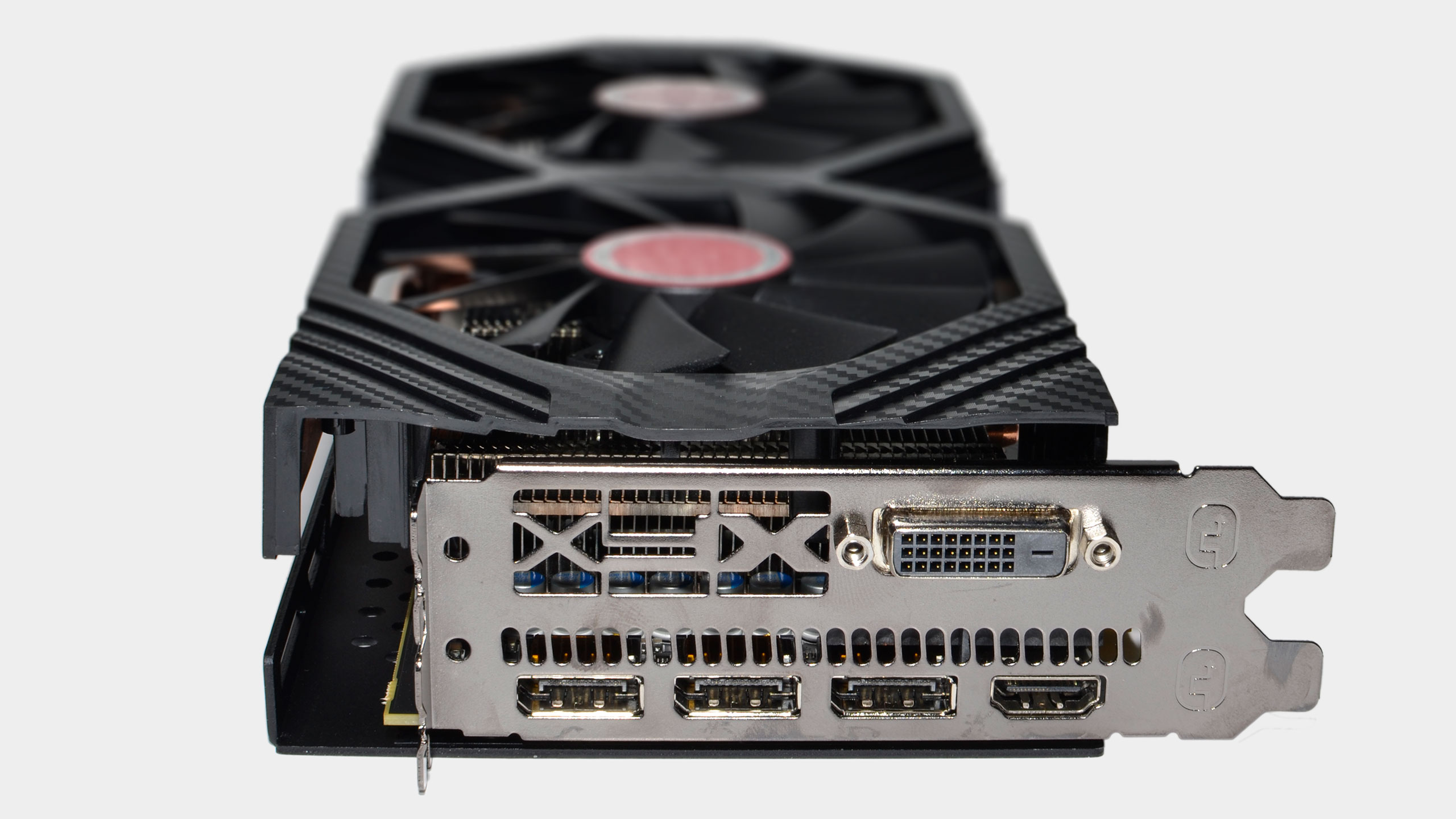
Still, it's hard not to be a bit disappointed at the outset. A 200MHz boost in clockspeeds is welcome news, but we're looking at an architecture that's over two years old. A straight process shrink is about the easiest update to any microprocessor that can be done. Some would argue that Nvidia would have been better off releasing a less expensive Pascal update instead of the new GeForce RTX line. Personally, I'd rather see larger changes and new features. Regardless, RX 590 and the Polaris 30 architecture are all we're getting for now. (Where's the 7nm love? Hopefully coming in early to mid 2019.)
As far as competition goes, right now Nvidia has left a gaping hole in its lineup. The RTX 2070 sits at $499, and the GTX 1080 is being phased out. I'm not sure if the GTX 1070 and 1070 Ti will stick around much longer, but right now they start at around $350 (after mail-in rebate). The next step down in pricing is a rather large drop, with the cheapest GTX 1060 6GB sitting at $230. Considering the RX 580 8GB already typically beats the GTX 1060 6GB, at least from the performance perspective, this should be an easy win for AMD. I expect Nvidia will have an answer with a new midrange GPU sometime in early to mid 2019—though it's still not clear if that will be an RTX 2060, maybe a GTX 2060, or something else.
If AMD were only going up against the GTX 1060 6GB, the RX 590 would look a lot better. The problem is there are a lot of RX 580 8GB cards still available, and at all-time low prices thanks to the end of the cryptocurrency fever. Multiple cards are available for $200, which is bad news for the RX 590. It's faster, but it's also $80 more expensive, at least going by MSRP. But AMD has something to sweeten the deal, and depending on your taste in games, it's pretty darn good.
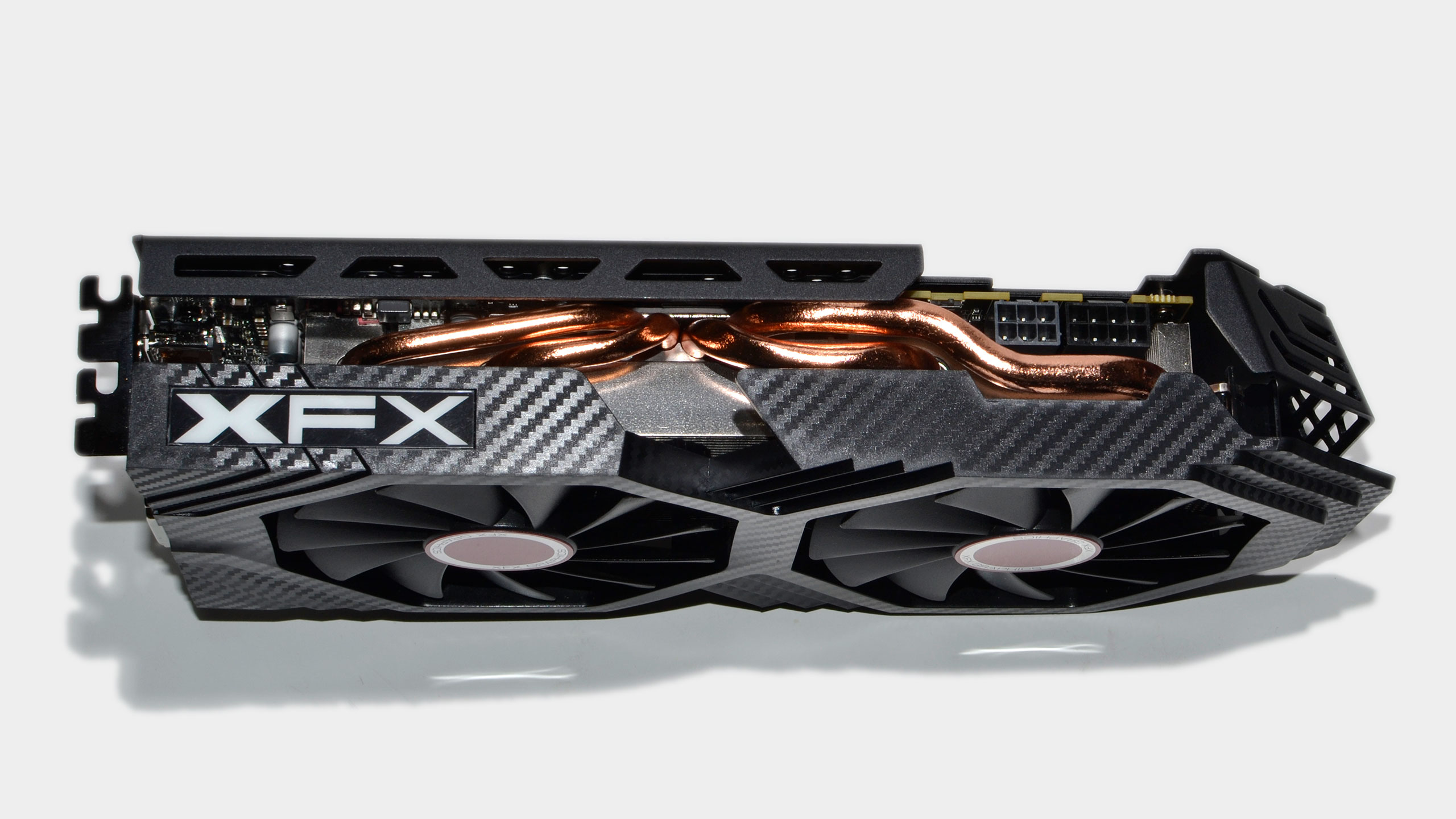
The initial RX 590 cards (at participating retailers) will come with a coupon for three free games—highly anticipated games for many, though none of the games are out yet. You'll get codes for the Resident Evil 2 remake (slated to launch January 25, 2019), The Division 2 (March 15, 2019), and Devil May Cry 5 (March 8, 2019). It's a bit of an odd bundle with the games all several months or more from release, but at least you won't already own them. Whether or not they're any good remains to be seen, but it's potentially $150-$180 in added value—one of the best gaming bundles we've seen in several years.
With no architectural changes to discuss—you can read about the Polaris architecture in our RX 480 launch review—let's move on to performance. AMD's GCN architectures have proven better at DirectX 12 games for the most part, but often come up short in DX11 games. Our current test suite includes six DX12 titles, seven DX11 games, and one Vulkan game. All GPUs are tested with the 'best' API, which means DX12 for AMD, but DX11 in a few cases (specifically Total War: Warhammer 2) for Nvidia.
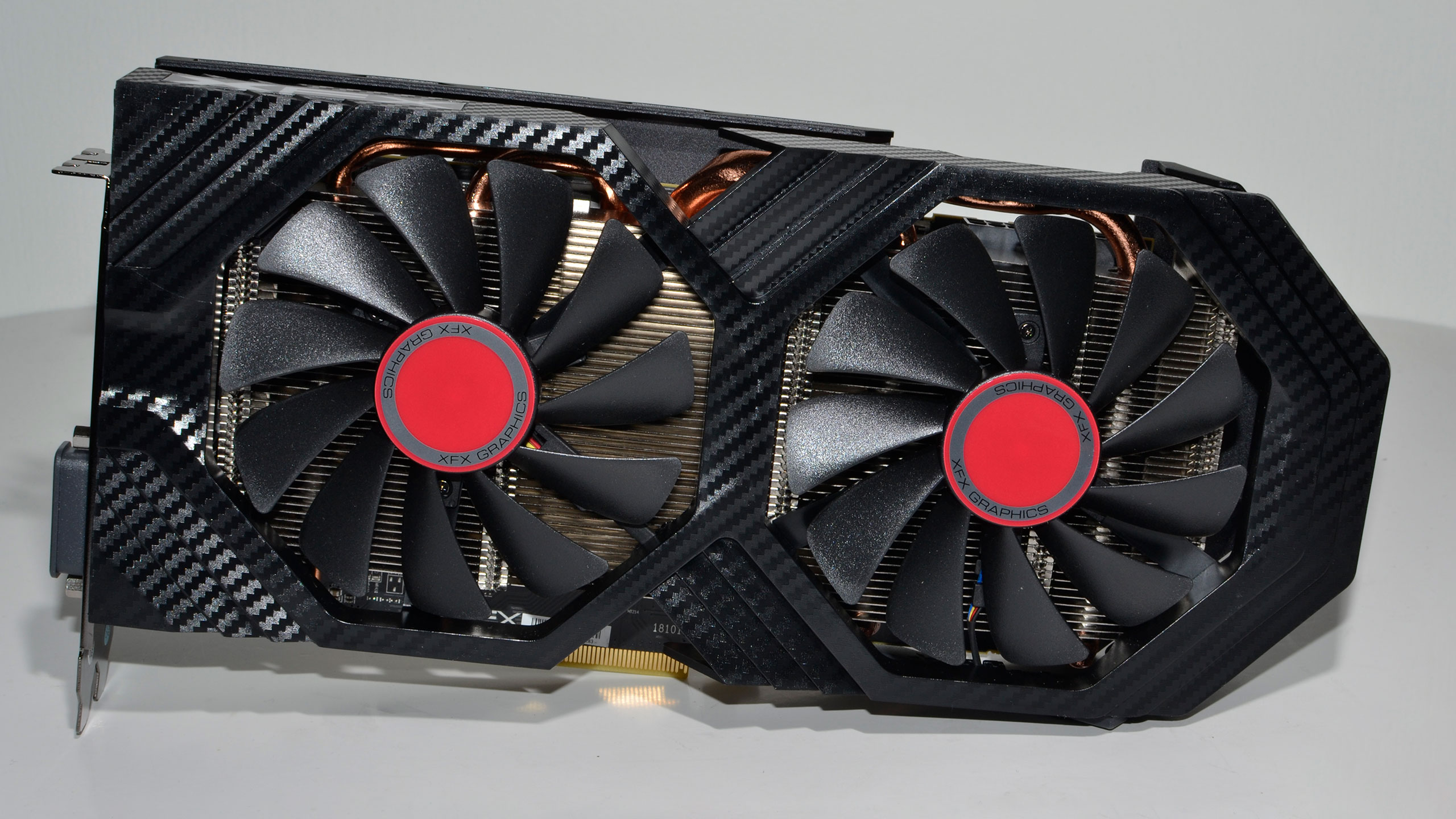
Radeon RX 590 performance
Something I've been trying to do with GPU launches of late is to check out overclocking potential. My experience with the RX 580/570 and RX 480/470 was relatively unimpressive for overclocking, but the RX 590 did okay. I managed a fully stable 1650MHz overclock on the GPU core (only 4.4 percent more than the XFX factory OC), but the GDDR5 I was able to max out the slider in MSI Afterburner at 9GT/s. I did have to increase GPU fan speeds a bit, but ended up with a peak of 75C during my full test suite and fan speed of around 60 percent. I'll include both 'stock' (factory overclocked) and manual overclocking results for the 590 in the charts.
Overclocking did increase system power use by around 50W while gaming. At stock, MSI Afterburner reports about 150W for the RX 590, while power at the outlet for the entire PC measures 320-340W. With the overclock in place, power jumps to around 370-400W for the entire PC. A GTX 1060 6GB by comparison has a system power draw while gaming of 250-270W.
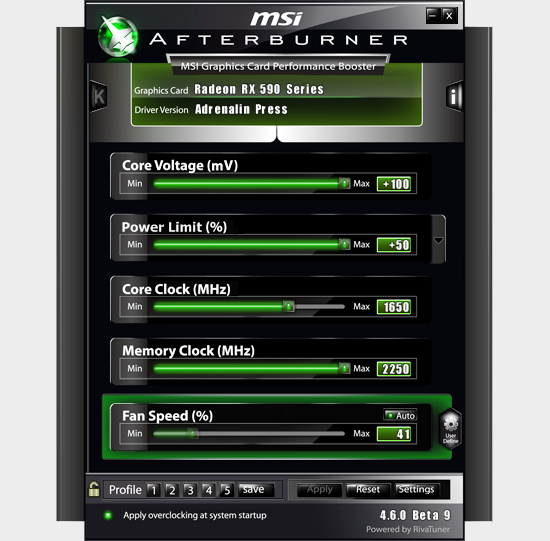
I retested all graphics cards for Nvidia's Turing launch, plus added a couple of new games since then. The new games were tested with the latest drivers available at the time, while the RX 590 uses AMD provided "18.40" drivers that should be similar in most respects to the current Adrenalin Edition 18.11.1 public drivers. The test PC uses a Core i7-8700K overclocked to 5.0GHz to help minimize CPU bottlenecks during testing, along with other high-end components.
Along with 1080p medium testing, I'm using 'maxed out' settings in 14 popular games for my primary benchmarks. That includes all the extras under GTA 5's advanced graphics menu (other than superscaling), HBAO+ in The Witcher 3, and so on. Some games punish cards with less than 6GB or even 8GB of VRAM at these settings, but the RX 590 and GTX 1060 6GB (along with higher end GPUs like the Vega 56 and GTX 1070) should be fine. The sweet spot for the RX 590 is definitely 1080p, typically at ultra quality. 1440p is often playable as well, perhaps with a step down on a few settings, while 4k users clearly aren't the intended audience.
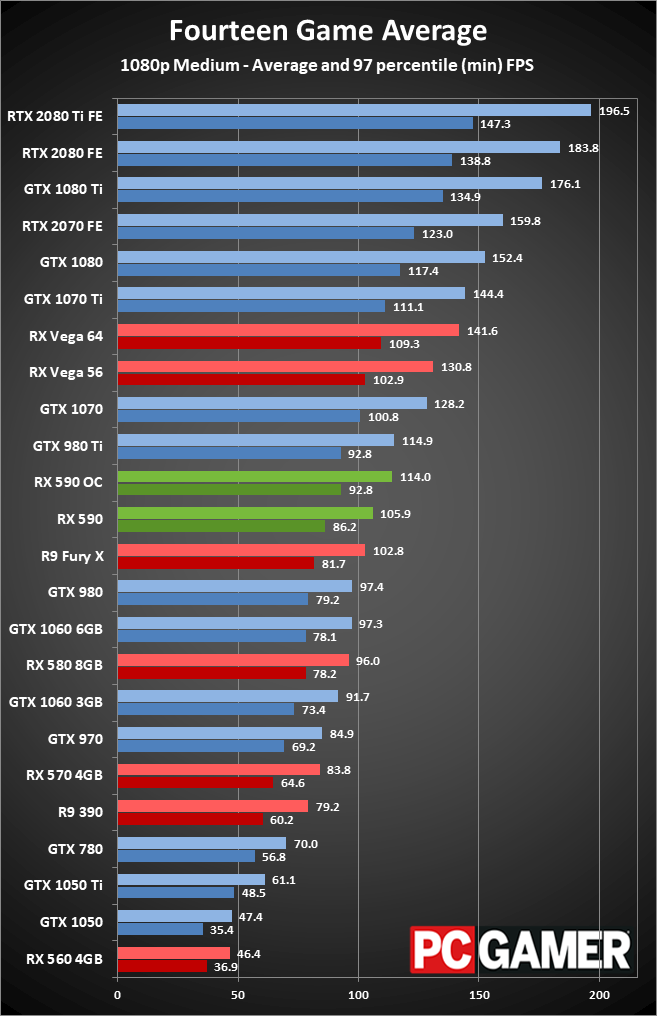
Swipe left/right for additional charts.
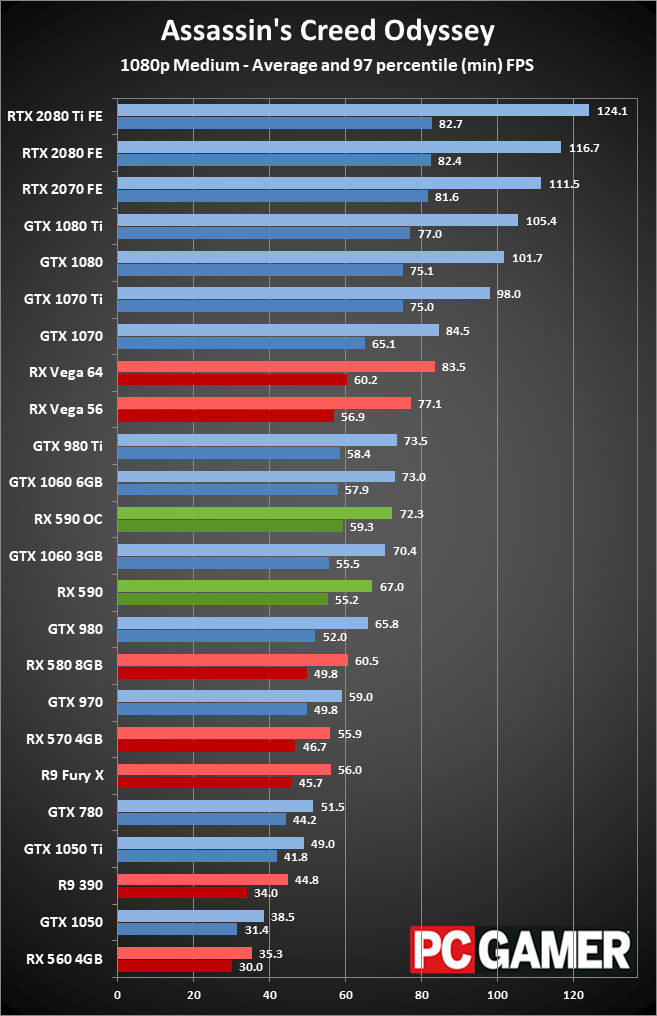
Swipe left/right for additional charts.
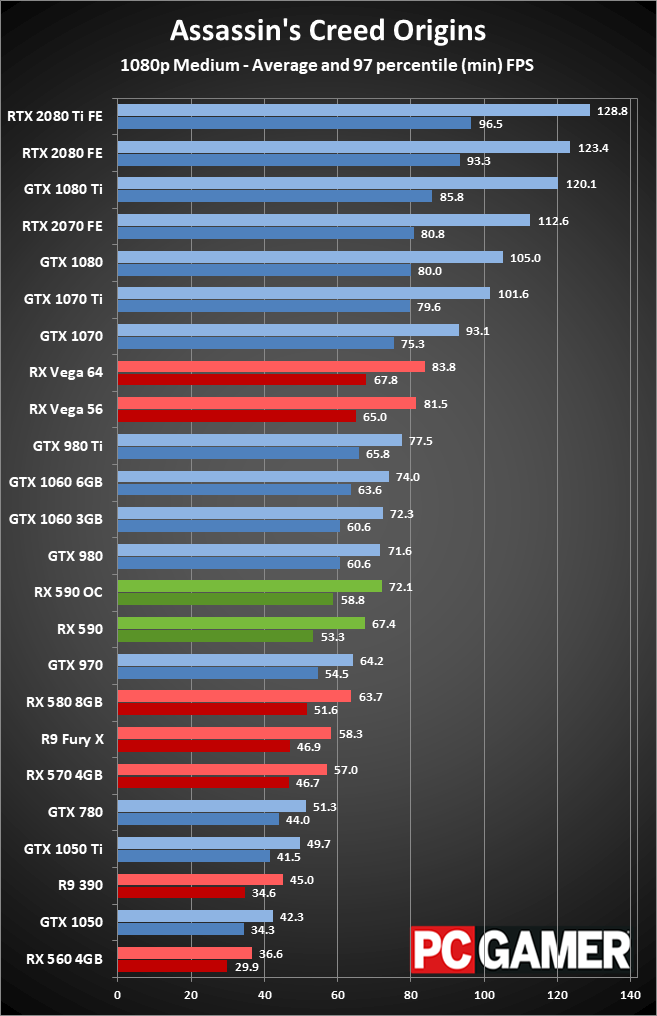
Swipe left/right for additional charts.
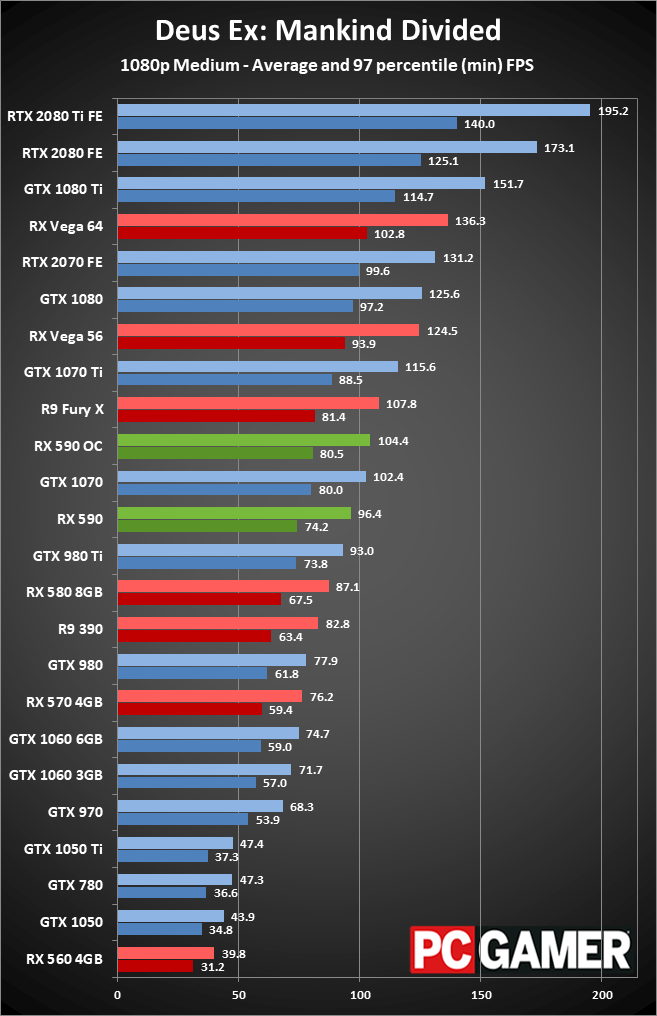
Swipe left/right for additional charts.
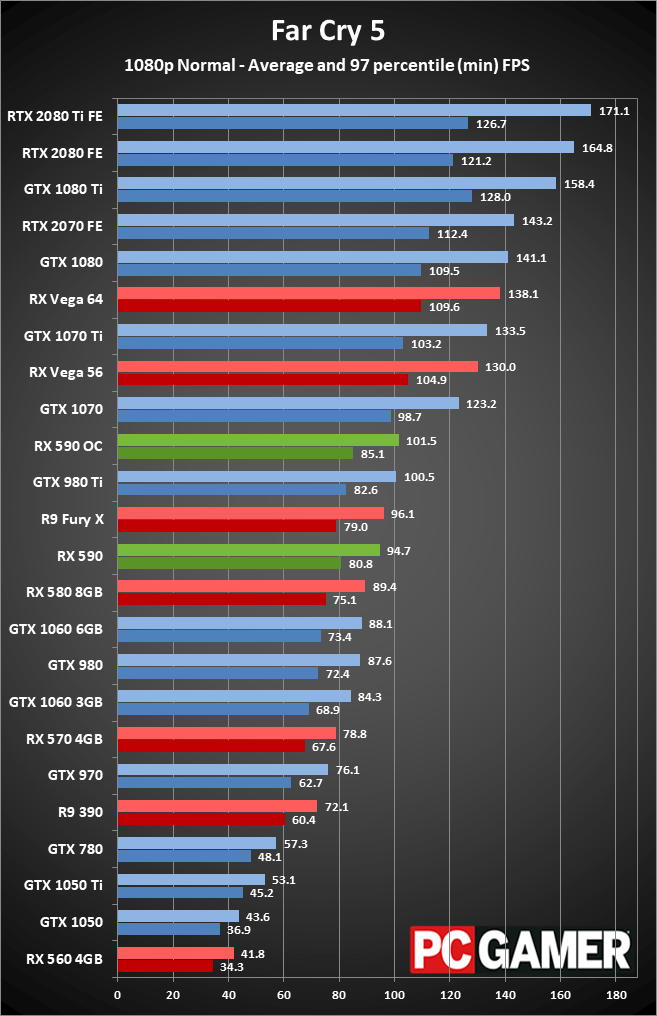
Swipe left/right for additional charts.
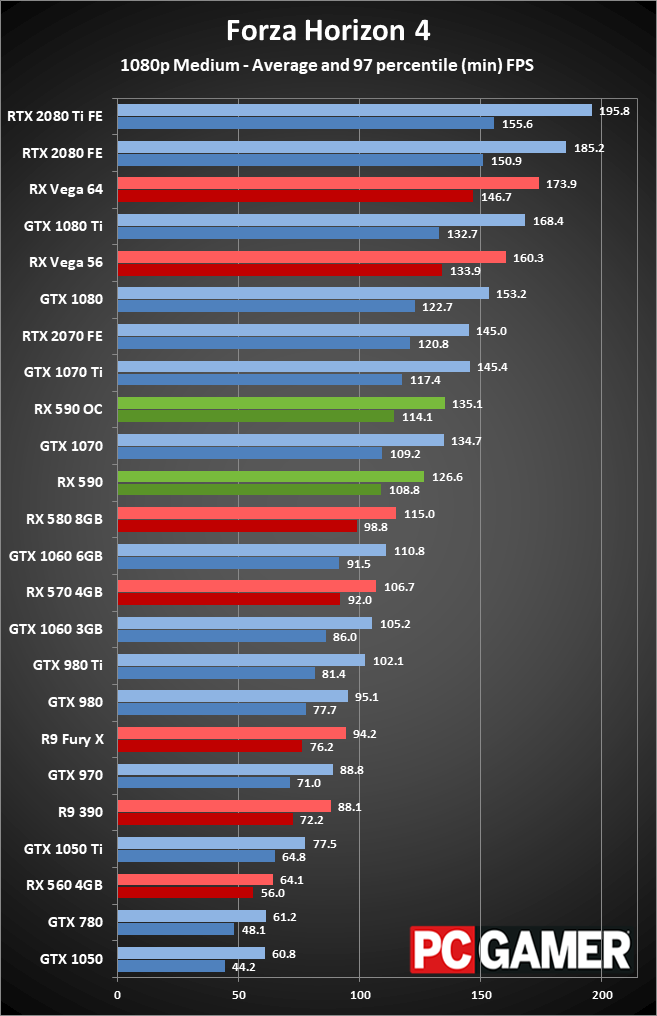
Swipe left/right for additional charts.
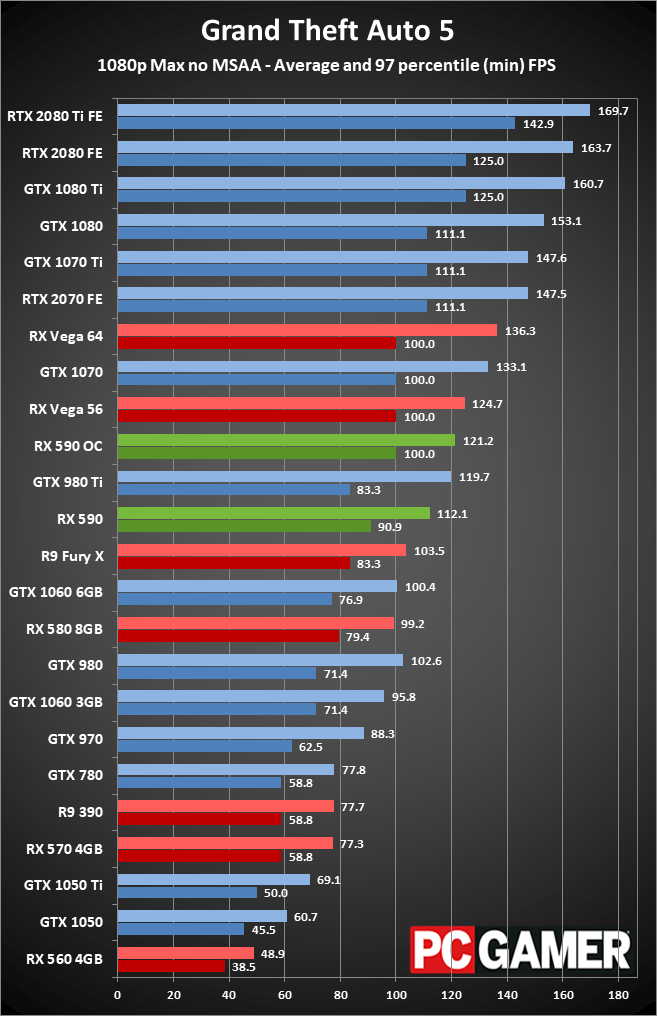
Swipe left/right for additional charts.
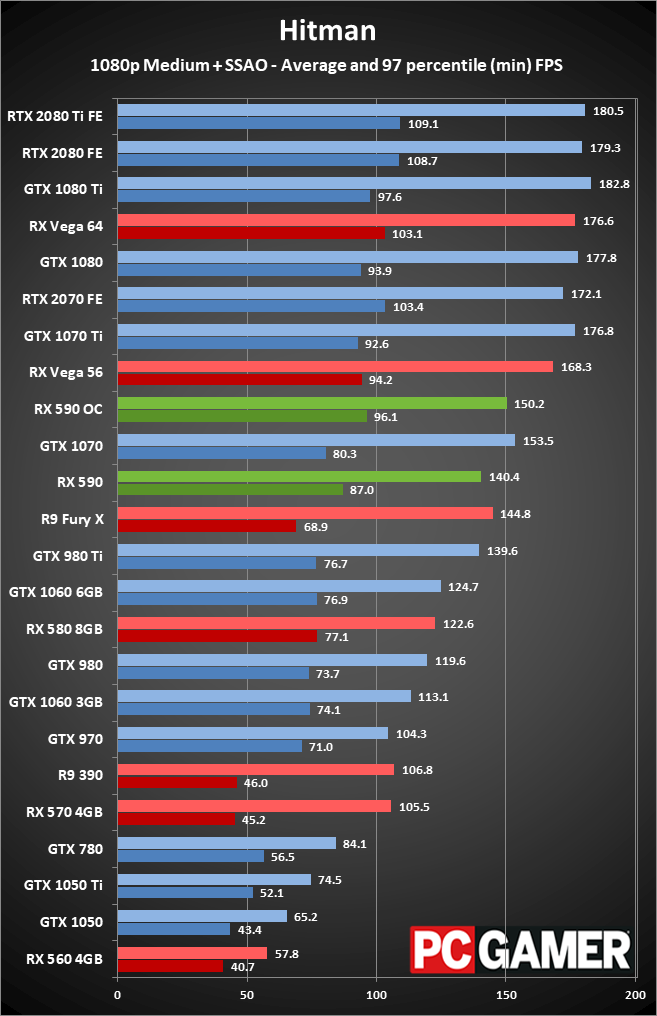
Swipe left/right for additional charts.
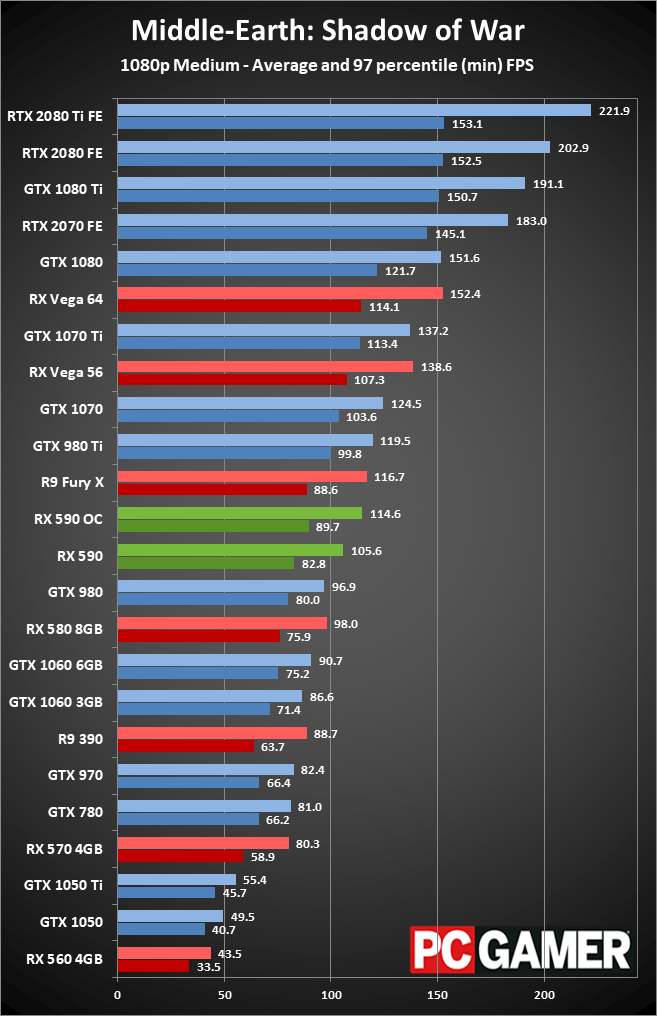
Swipe left/right for additional charts.
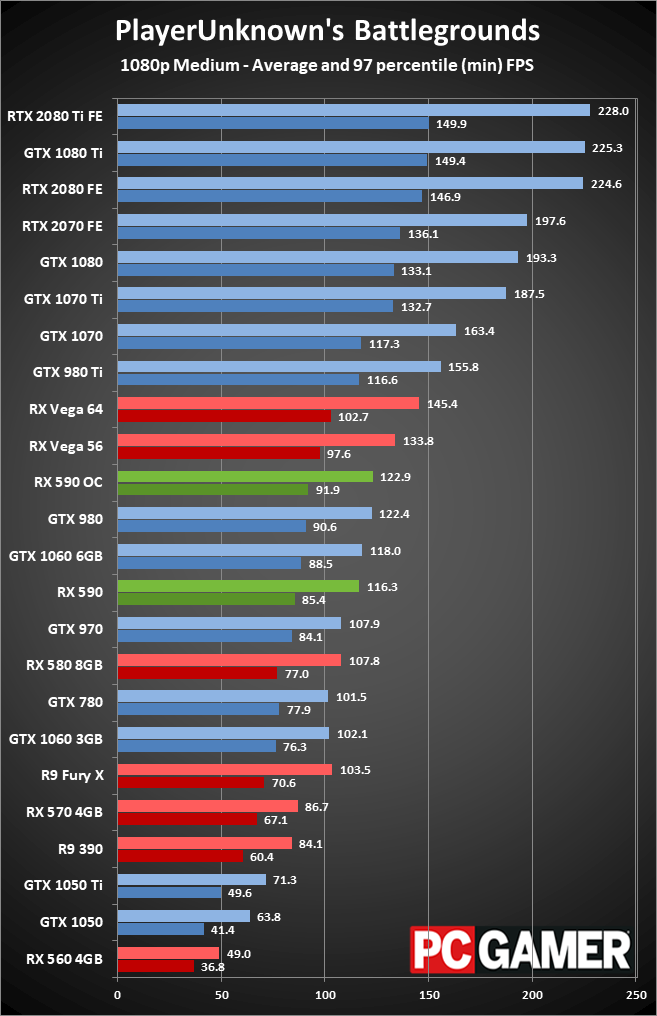
Swipe left/right for additional charts.
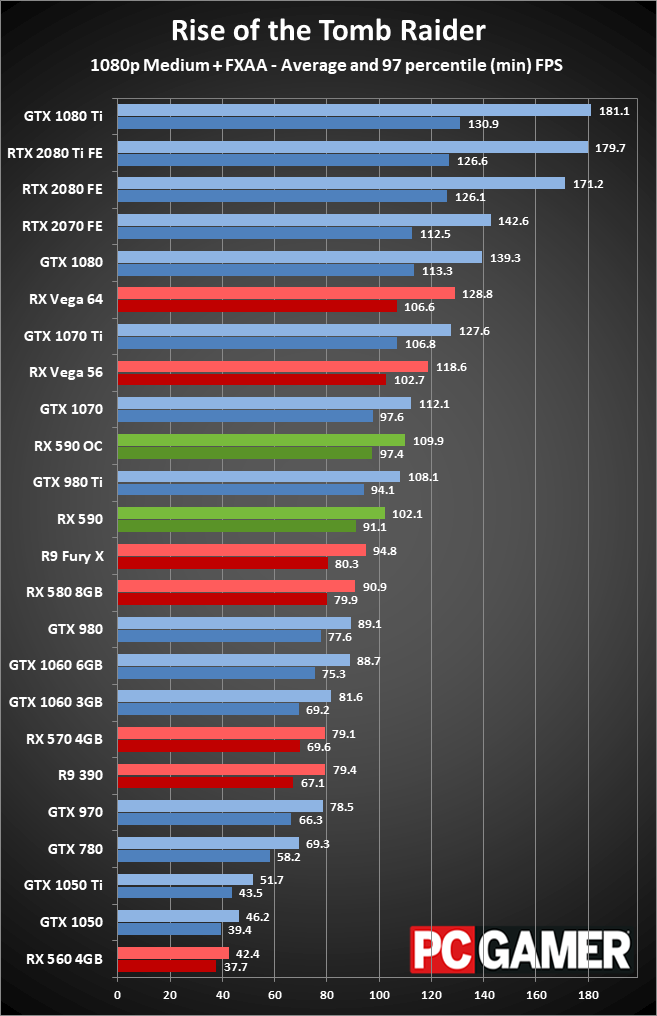
Swipe left/right for additional charts.
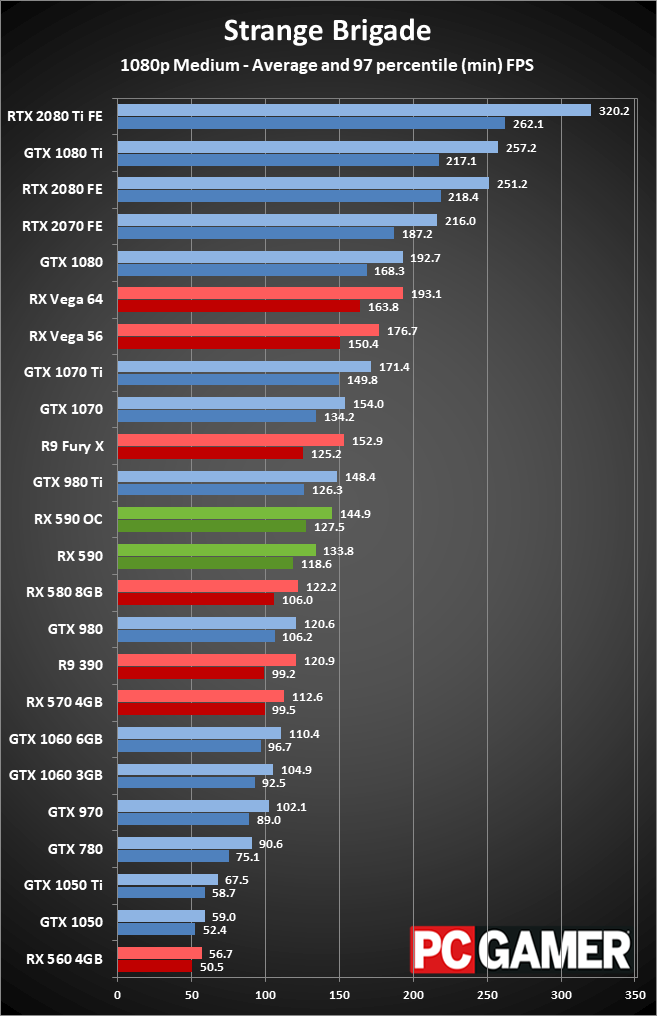
Swipe left/right for additional charts.
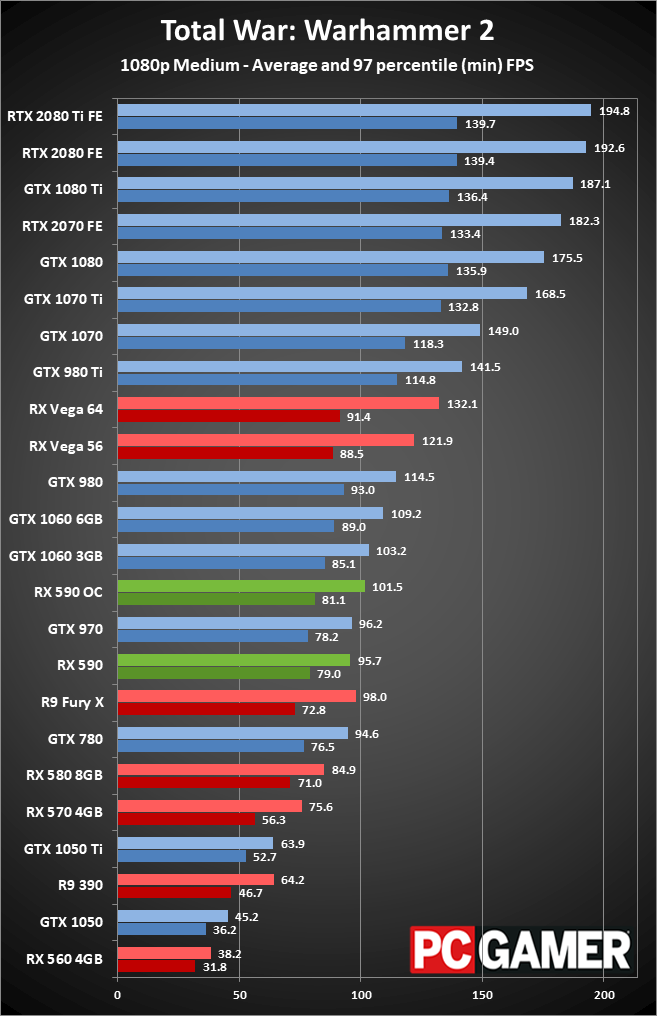
Swipe left/right for additional charts.
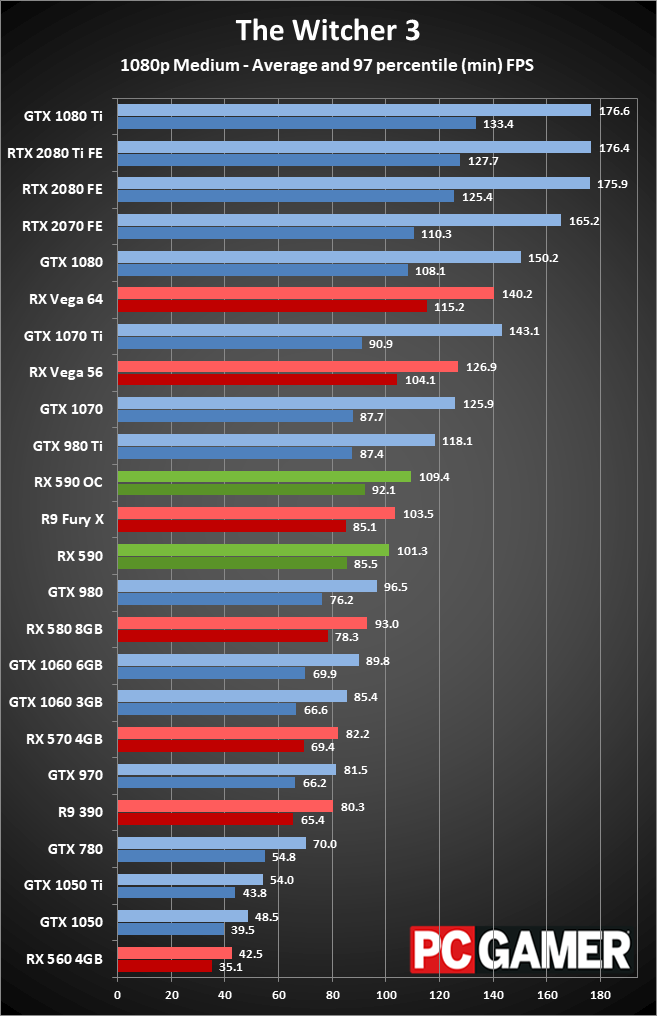
Swipe left/right for additional charts.
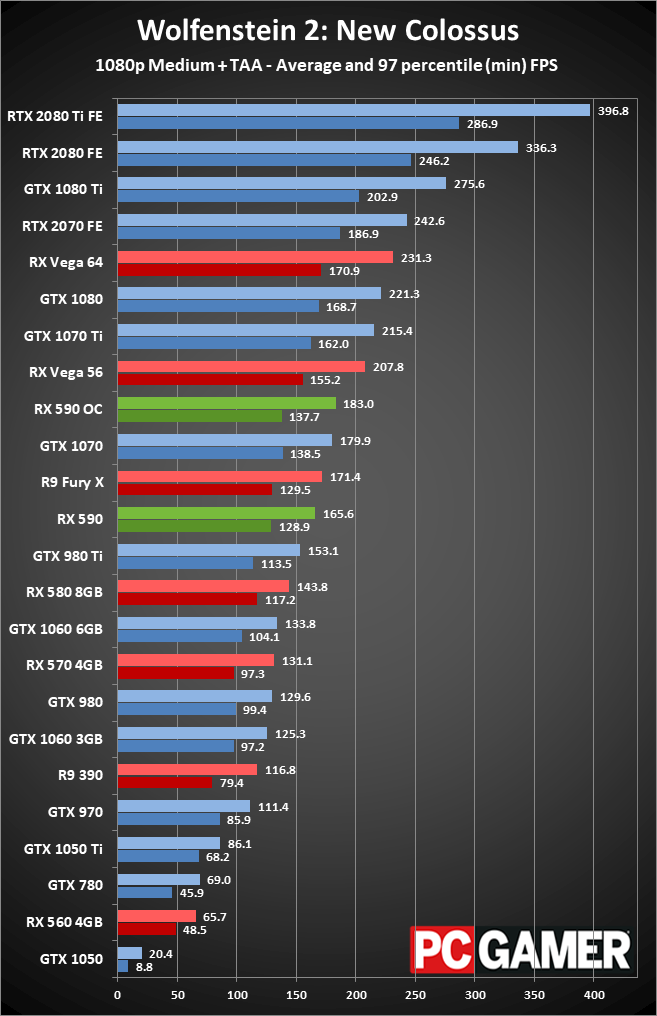
Swipe left/right for additional charts.
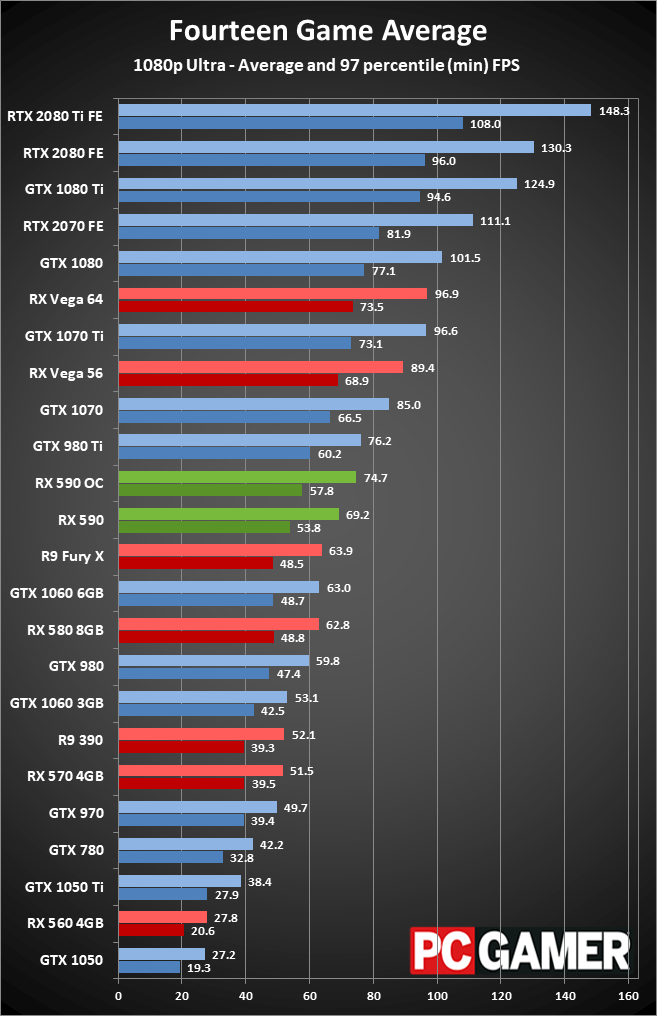
Swipe left/right for additional charts.
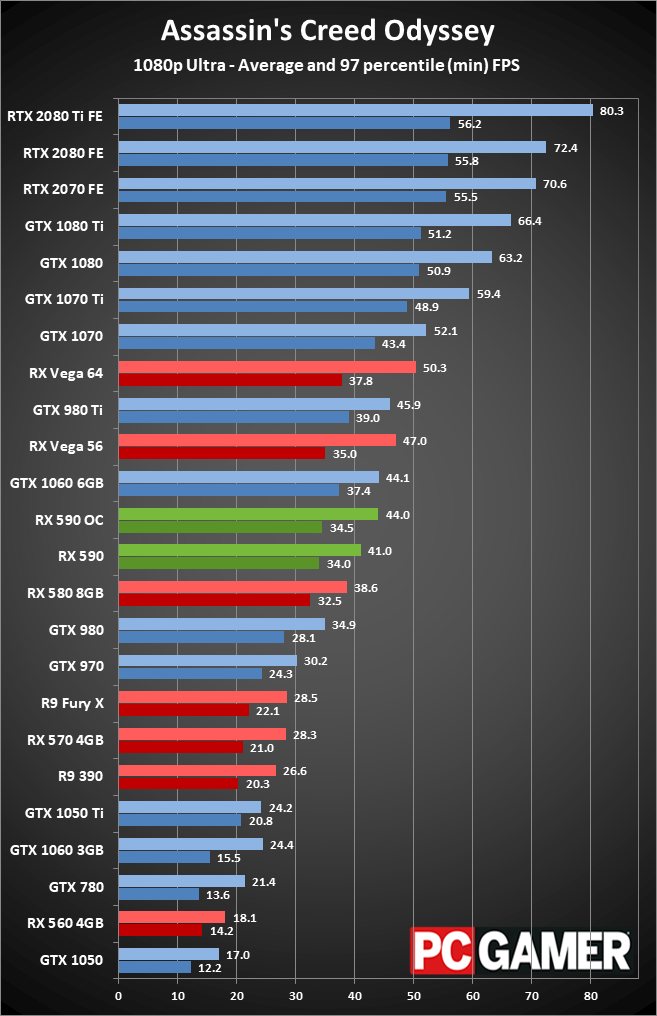
Swipe left/right for additional charts.
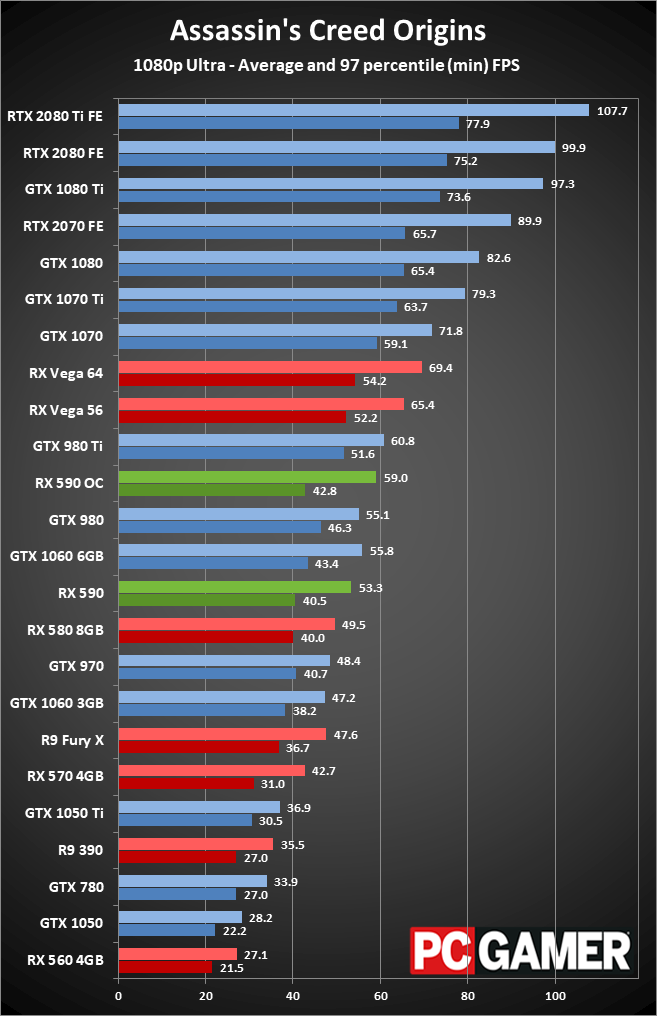
Swipe left/right for additional charts.
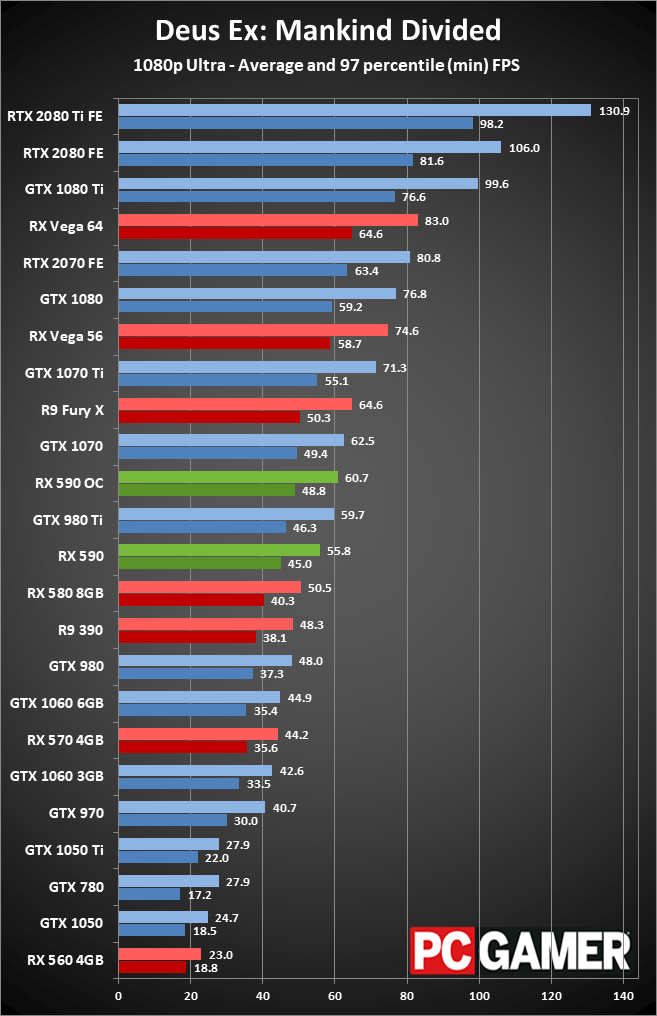
Swipe left/right for additional charts.
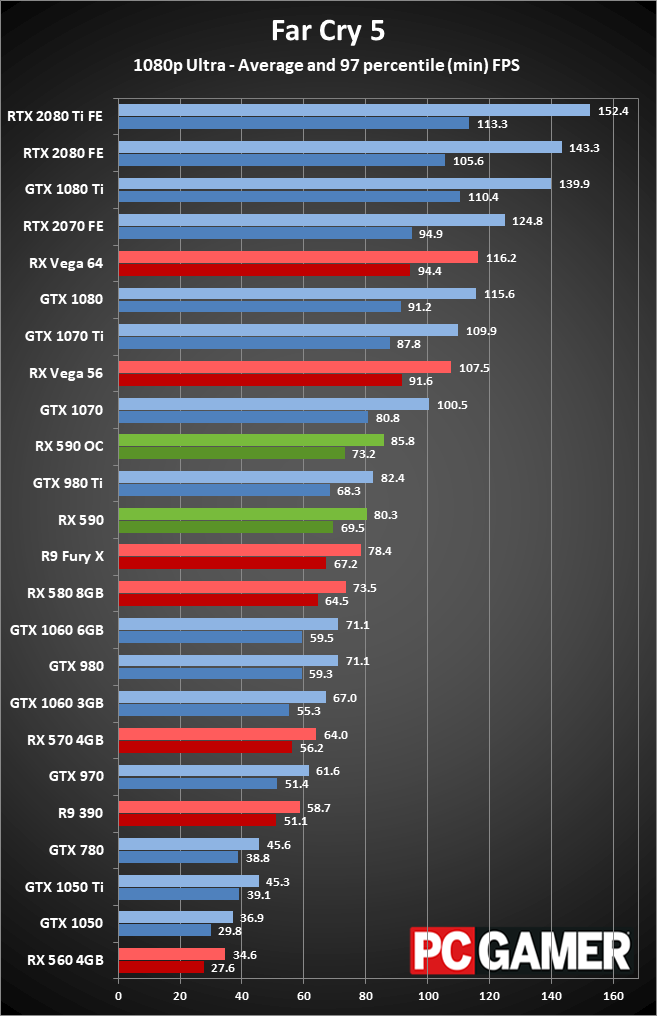
Swipe left/right for additional charts.
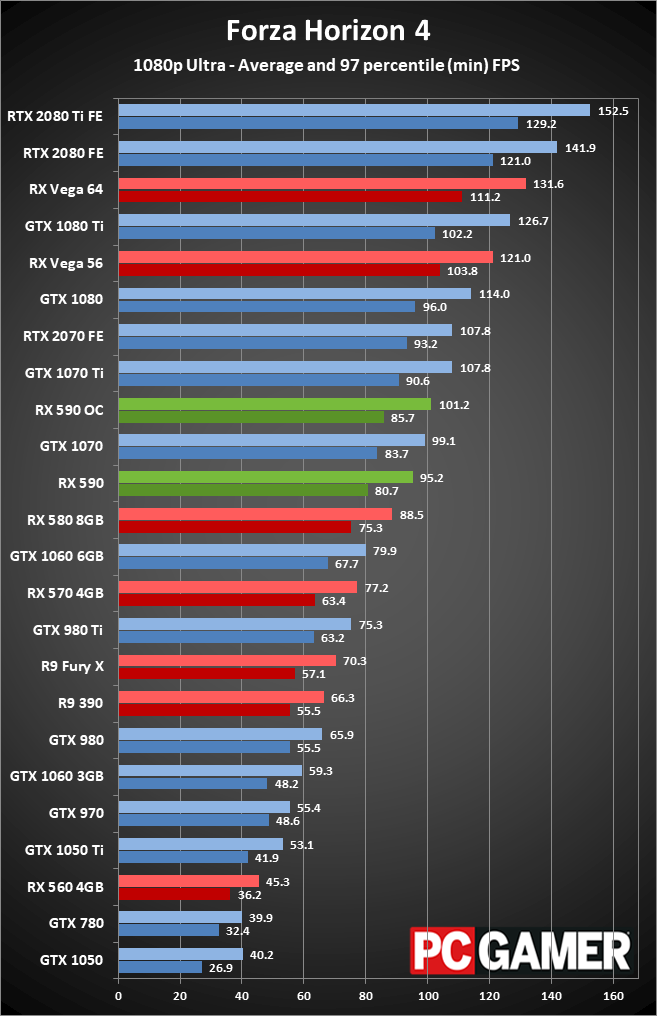
Swipe left/right for additional charts.
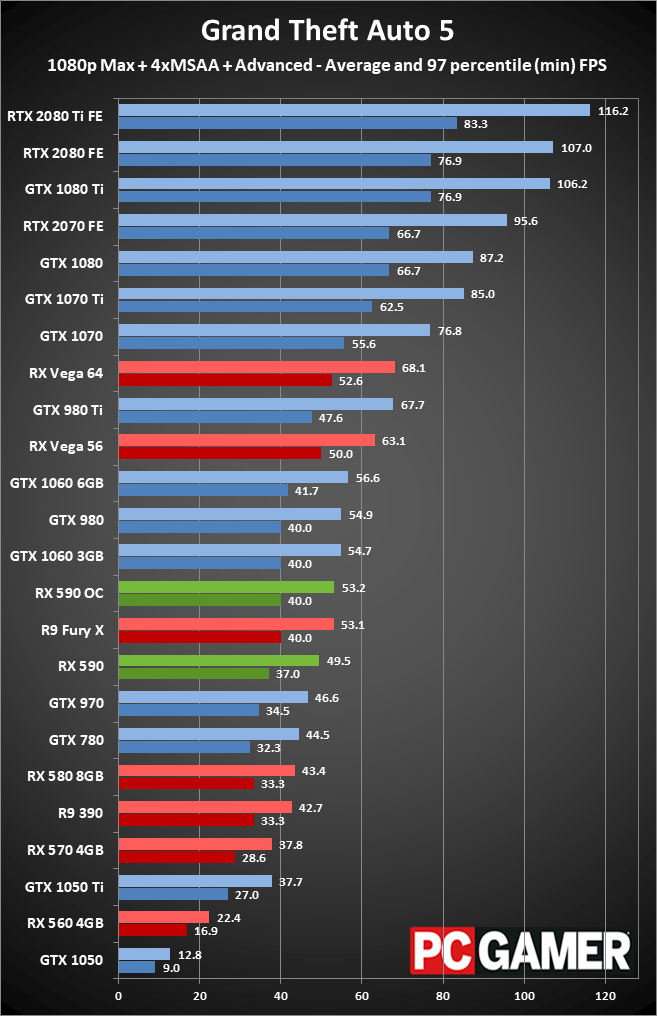
Swipe left/right for additional charts.
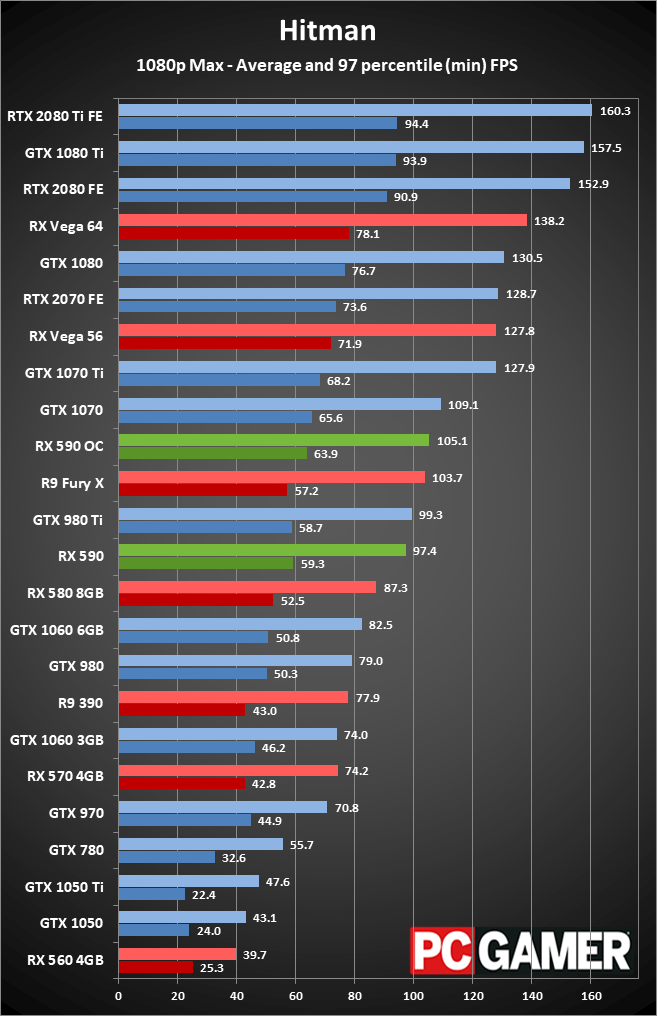
Swipe left/right for additional charts.
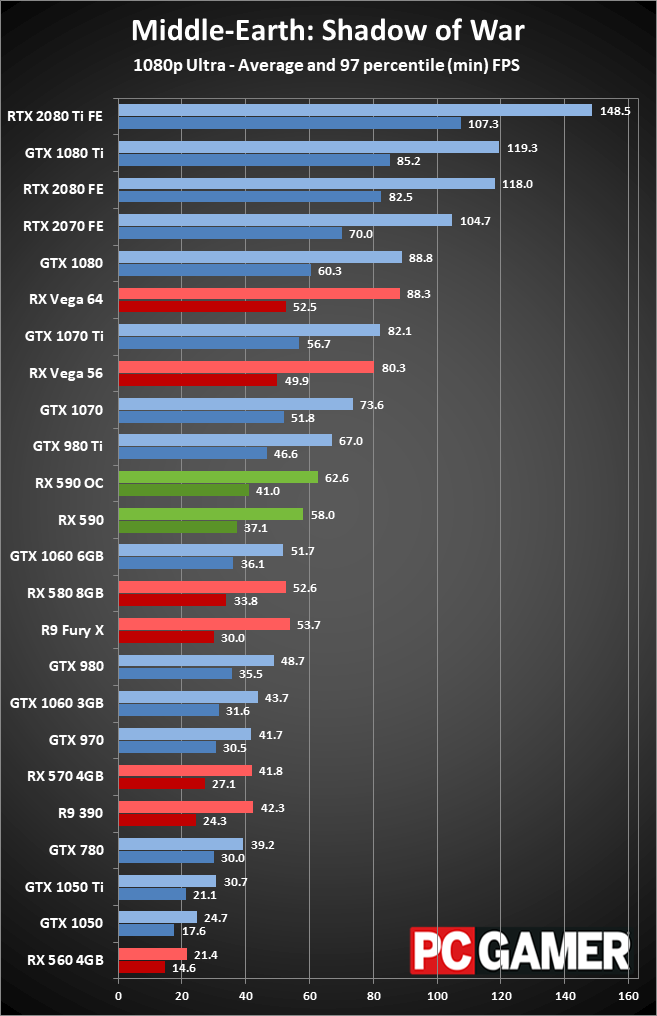
Swipe left/right for additional charts.
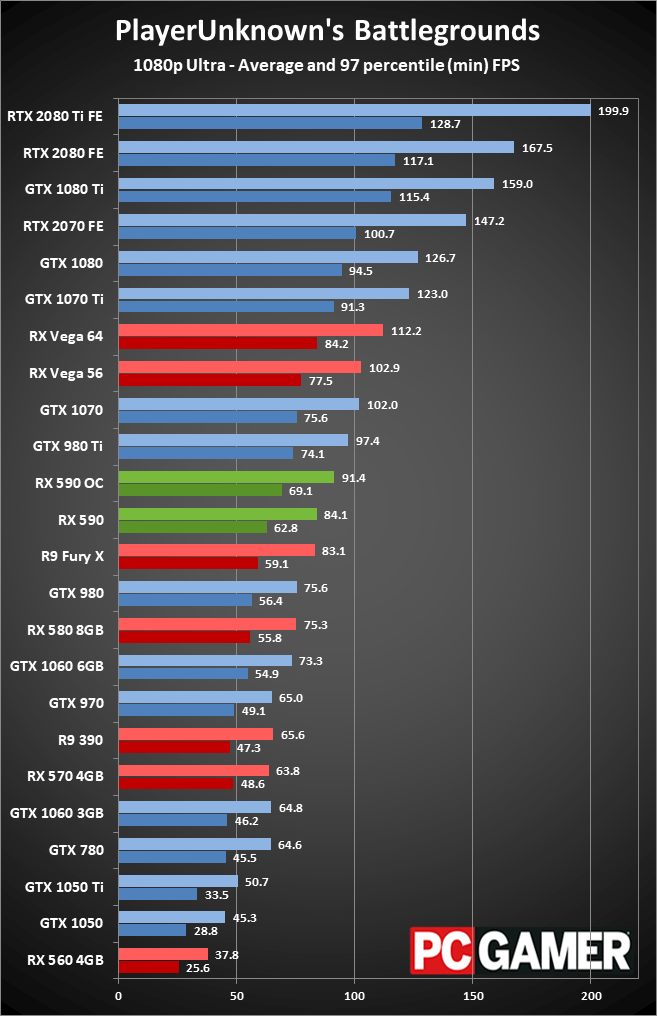
Swipe left/right for additional charts.
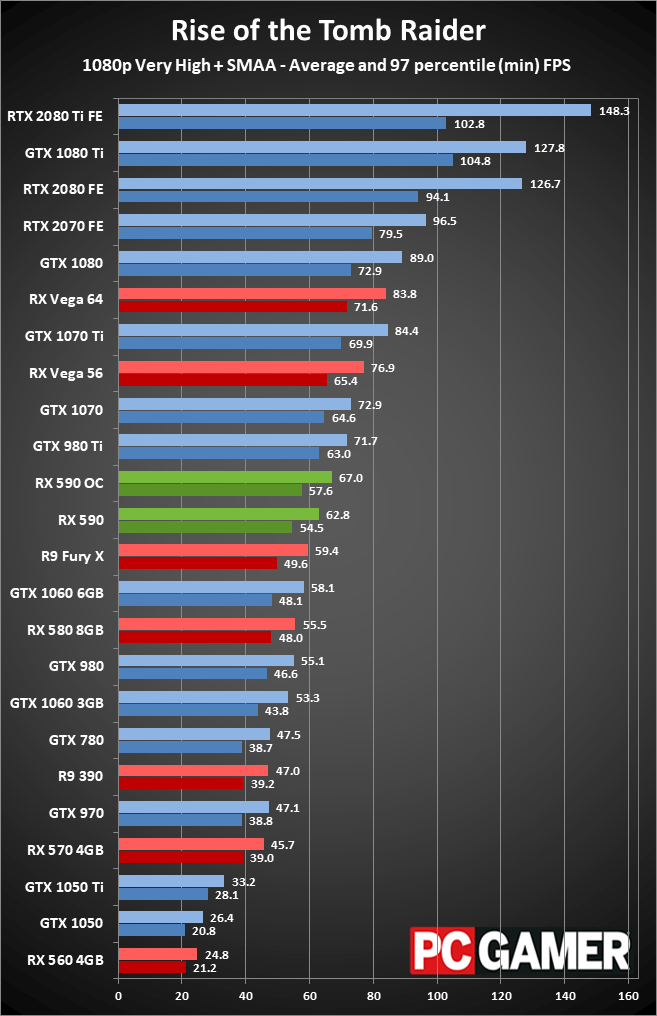
Swipe left/right for additional charts.
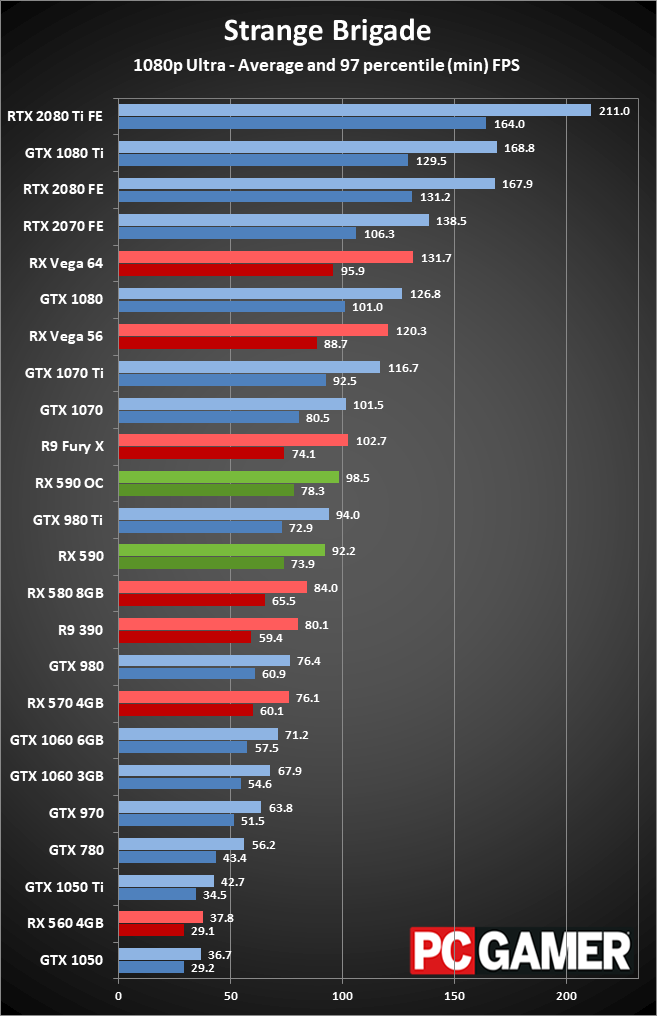
Swipe left/right for additional charts.

Swipe left/right for additional charts.
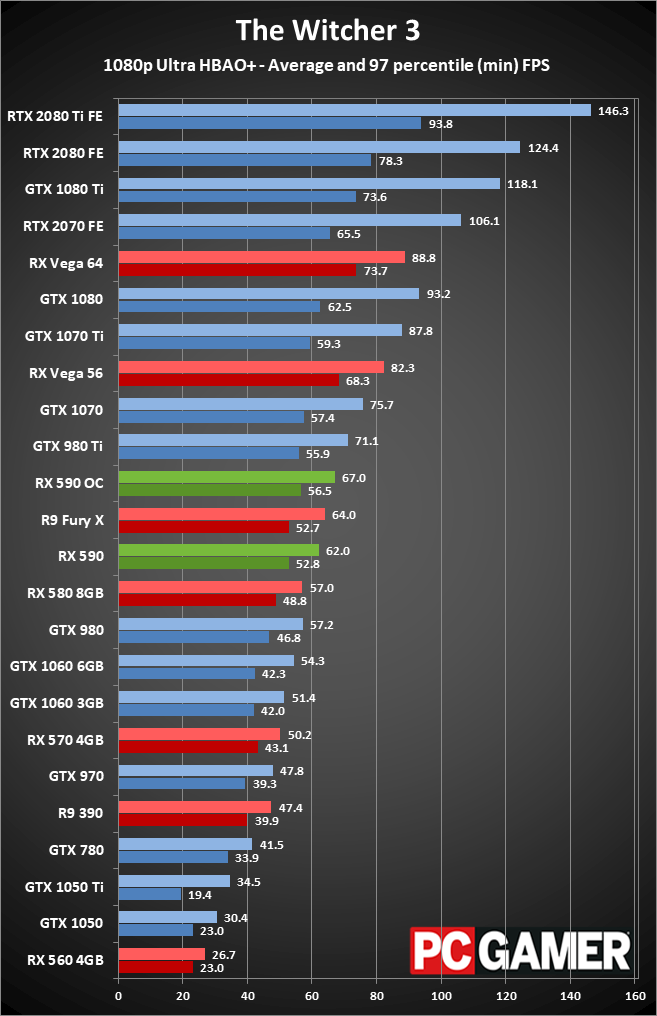
Swipe left/right for additional charts.
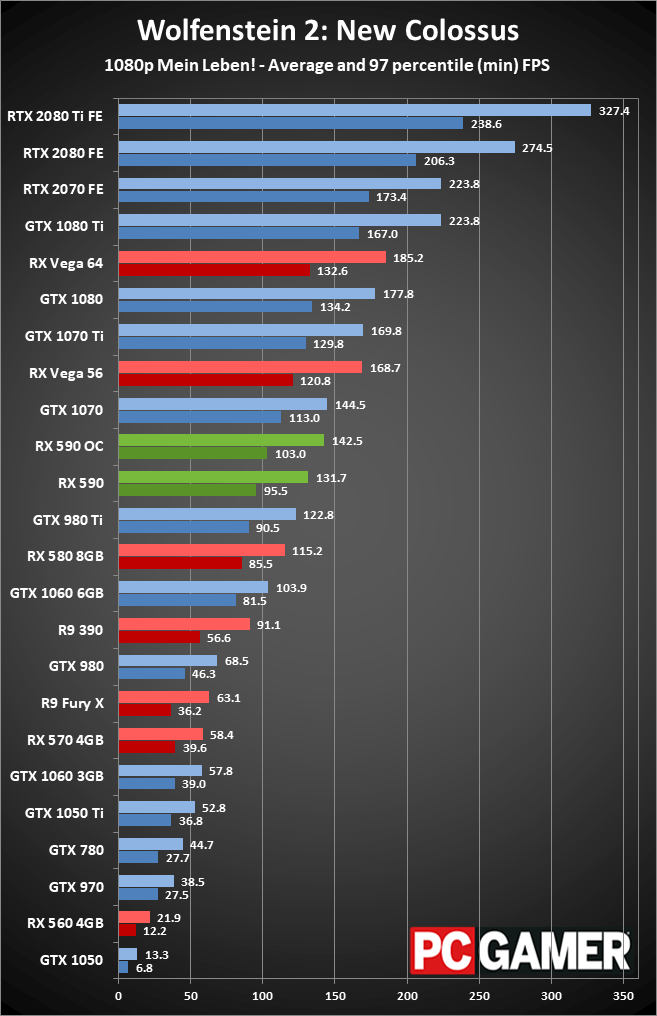
Swipe left/right for additional charts.
Starting with 1080p at both medium and 'ultra' settings, the RX 590 looks great. It's about 10 percent faster than a GTX 1060 6GB at 1080p, and likewise 10 percent faster than the RX 580 8GB. Factory overclocked parts would narrow the gap a few percent, but the RX 590 is clearly the fastest sub-$300 graphics card right now.
AMD's new GPU claims decisive wins in Deus Ex, Forza, Hitman, Strange Brigade, and Wolfenstein 2, leading by 20 percent or more at 1080p ultra. Most other games are also in AMD's core, but it's not a clean sweep of the gaming benchmarks. Both Assassin's Creed games favor Nvidia at 1080p, and GTA 5 at maxed out settings (including all the advanced graphics options) is a weak showing. Interestingly, Warhammer 2 also favors Nvidia's 1060 6GB—though it's running DX11 vs. DX12, as the DX12 code (which is 'beta' still) performs rather abysmally on Nvidia GPUs.
Average framerates across the tested games are well above 60fps, and over 100fps at medium quality. One of AMD's selling points is that Freesync displays are widely available—just about any new non-G-Sync display is likely to use Freesync these days, and the price premium over fixed refresh rate displays is negligible. If you're looking at buying a 1080p or 1440p Freesync monitor, the RX 590 will be a good match. That's because even while average fps is over 60, there are several games that fall short—both Assassin's Creed games, Deus Ex, GTA 5, Shadow of War, and Warhammer 2 all dip below 60 (granted, at max detail). Medium quality on the other hand is no problem, with everything easily breaking 60fps.
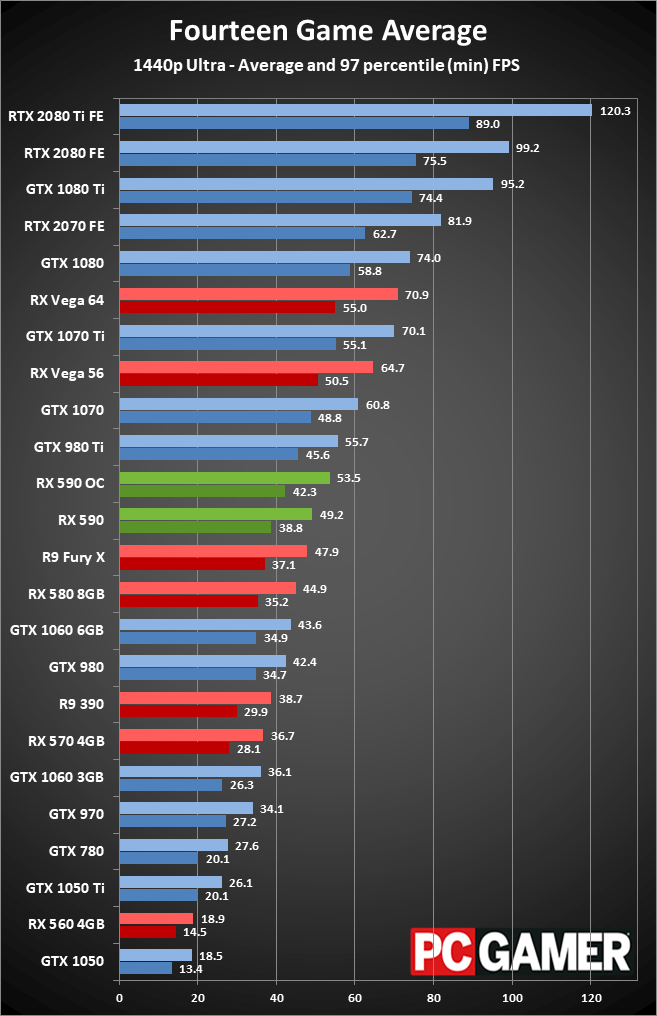
Swipe left/right for additional charts.
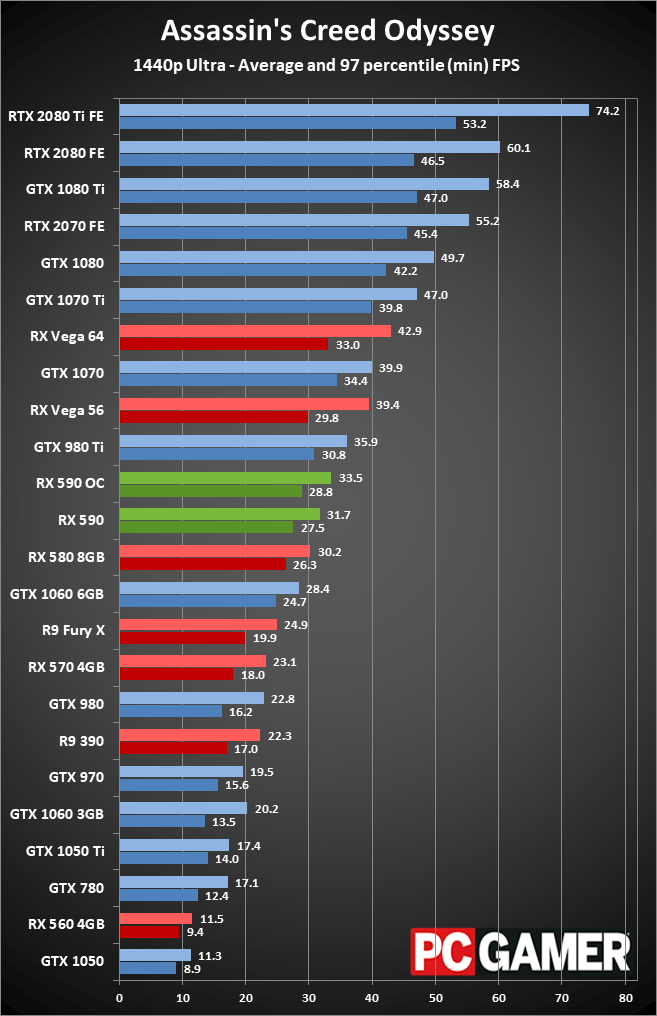
Swipe left/right for additional charts.
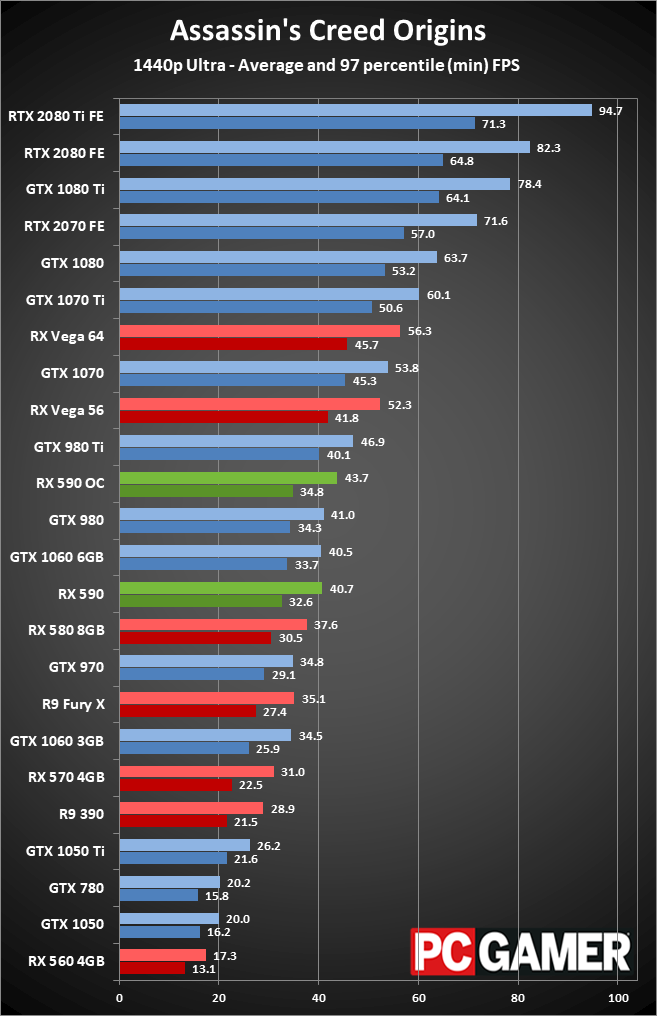
Swipe left/right for additional charts.
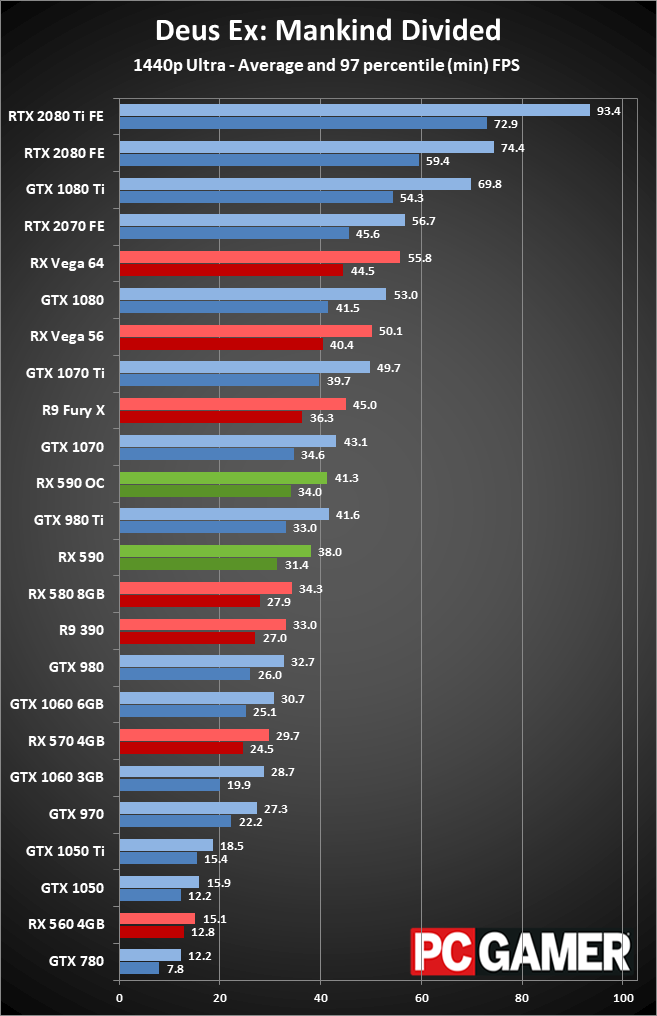
Swipe left/right for additional charts.
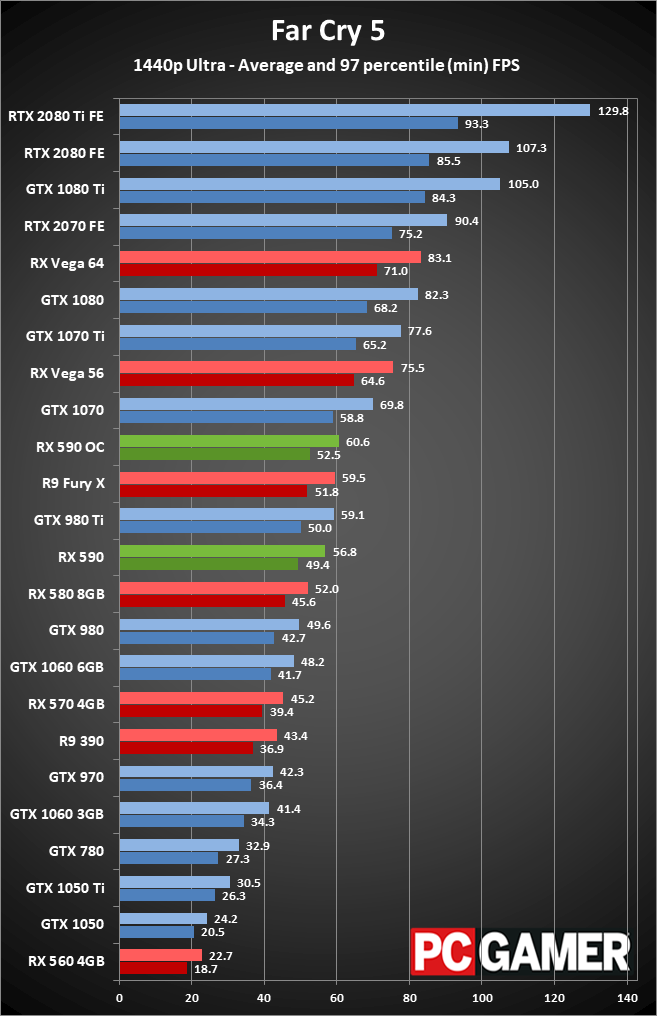
Swipe left/right for additional charts.
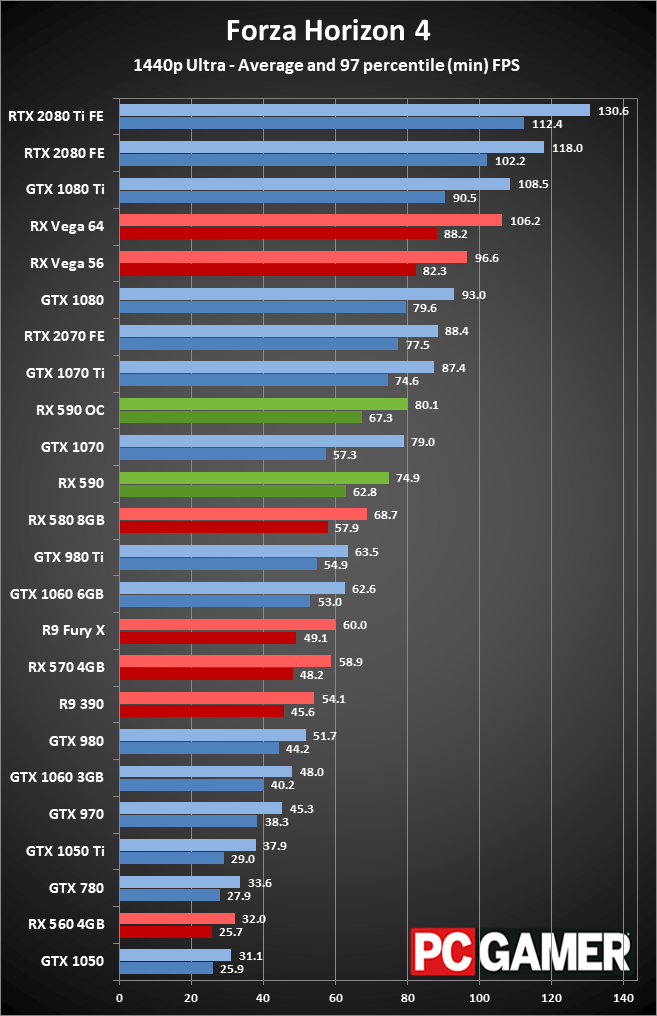
Swipe left/right for additional charts.
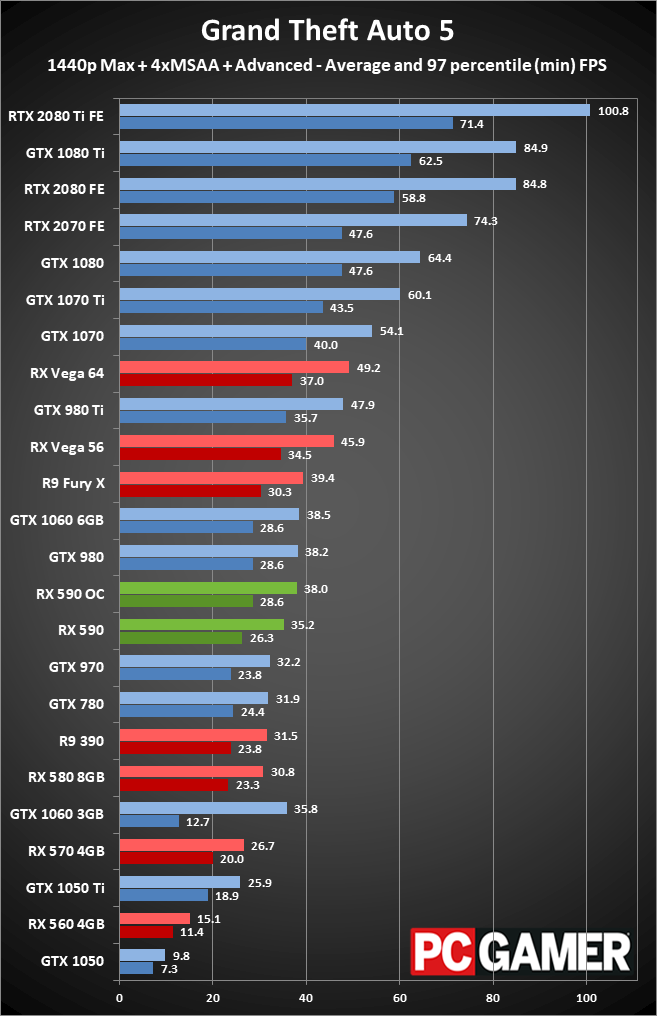
Swipe left/right for additional charts.

Swipe left/right for additional charts.
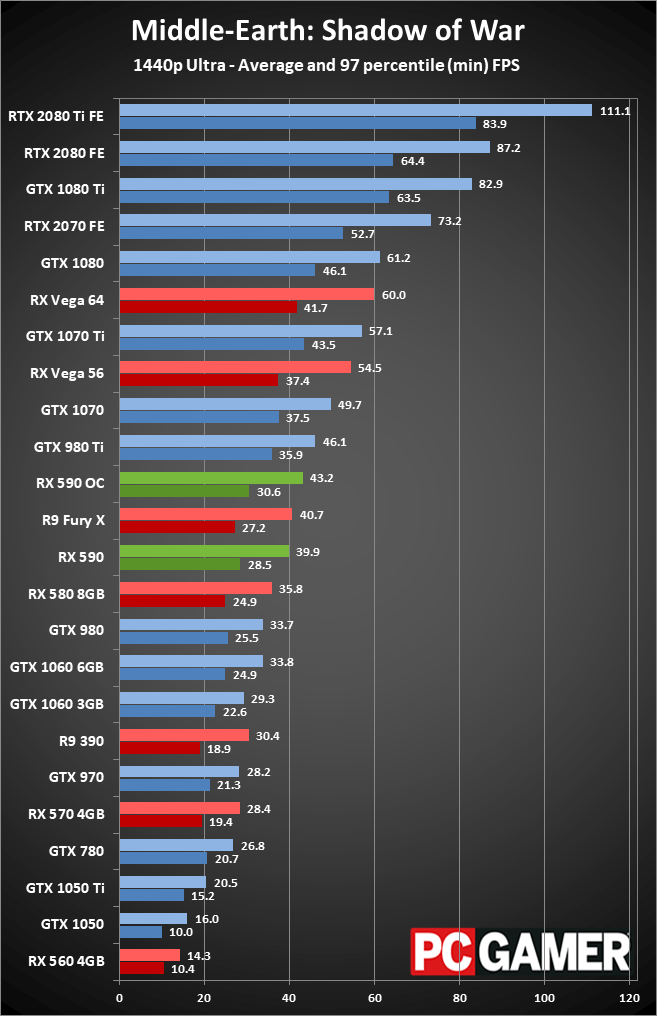
Swipe left/right for additional charts.
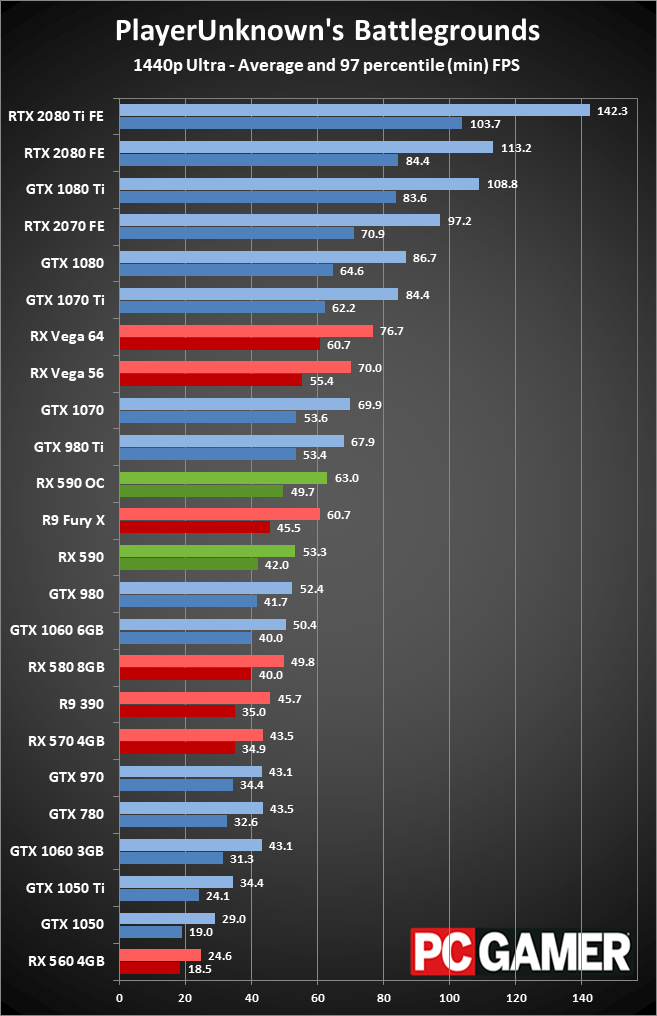
Swipe left/right for additional charts.
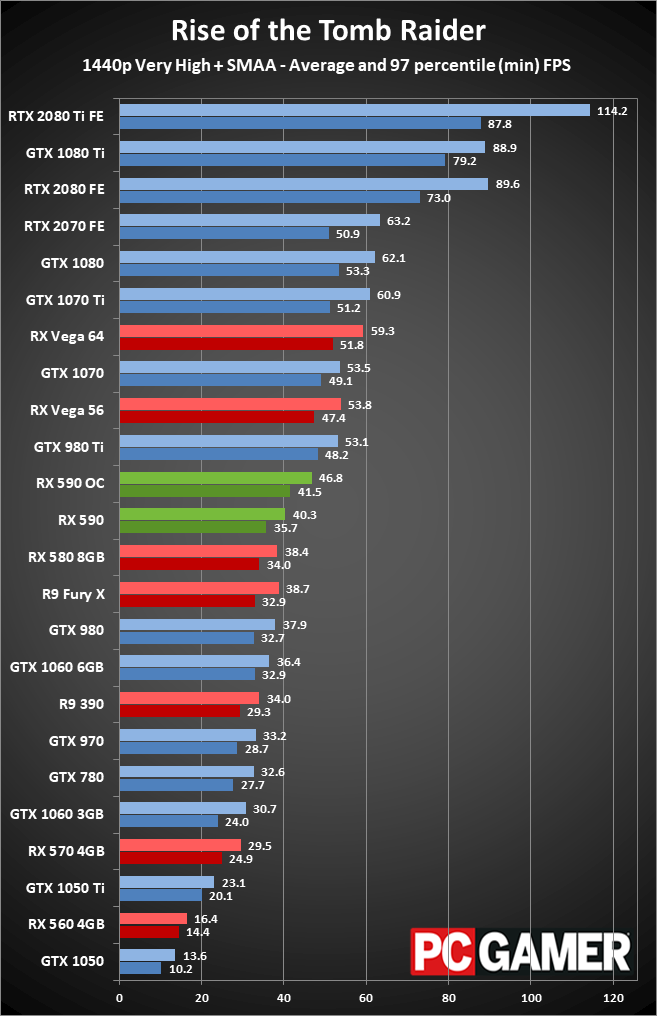
Swipe left/right for additional charts.
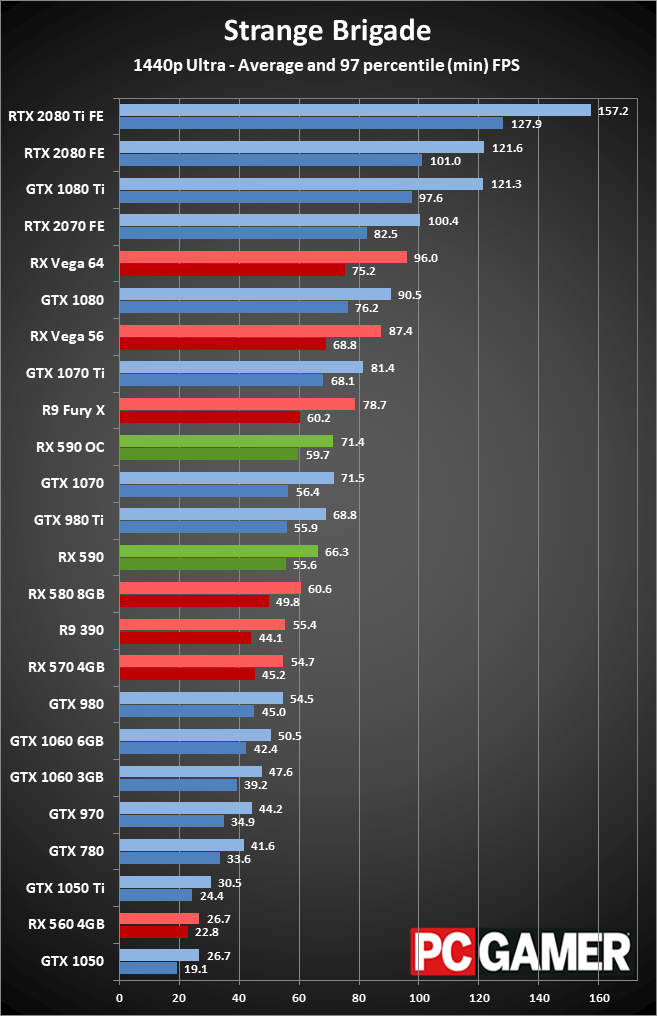
Swipe left/right for additional charts.
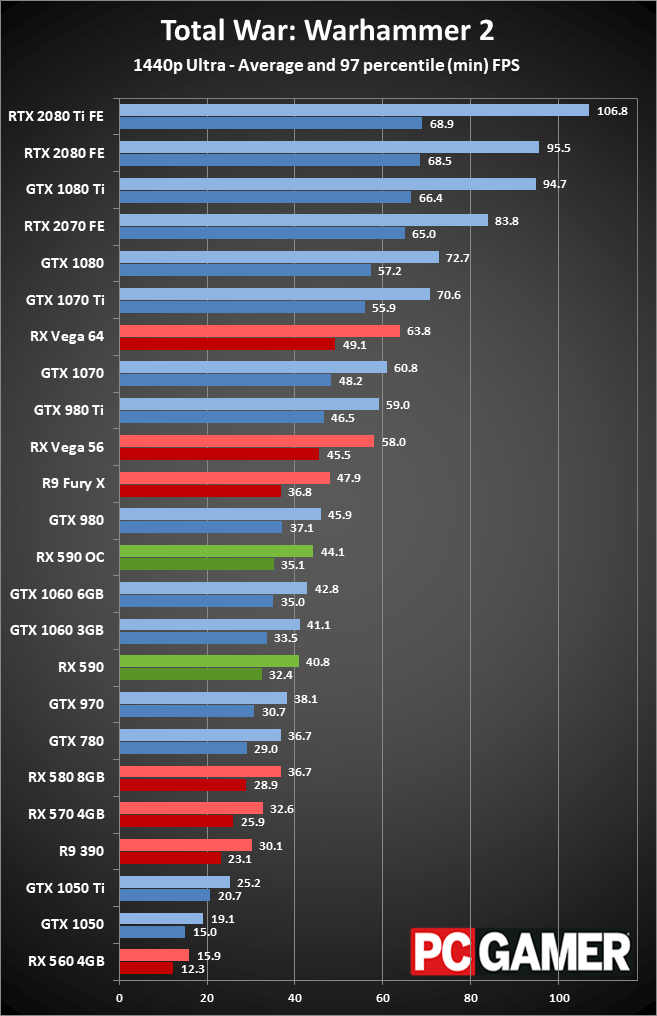
Swipe left/right for additional charts.
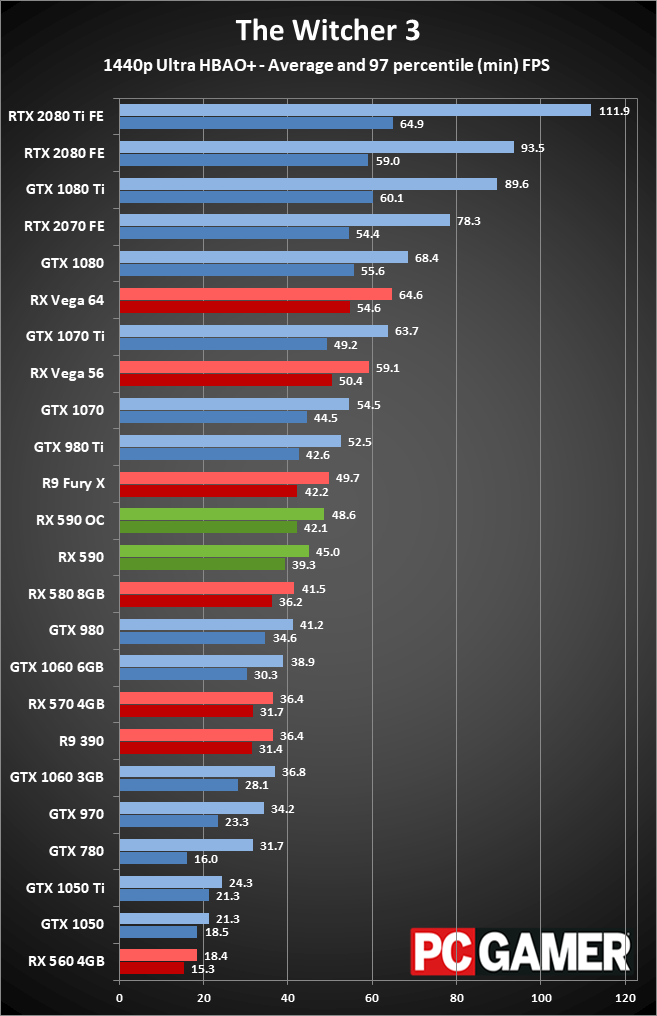
Swipe left/right for additional charts.
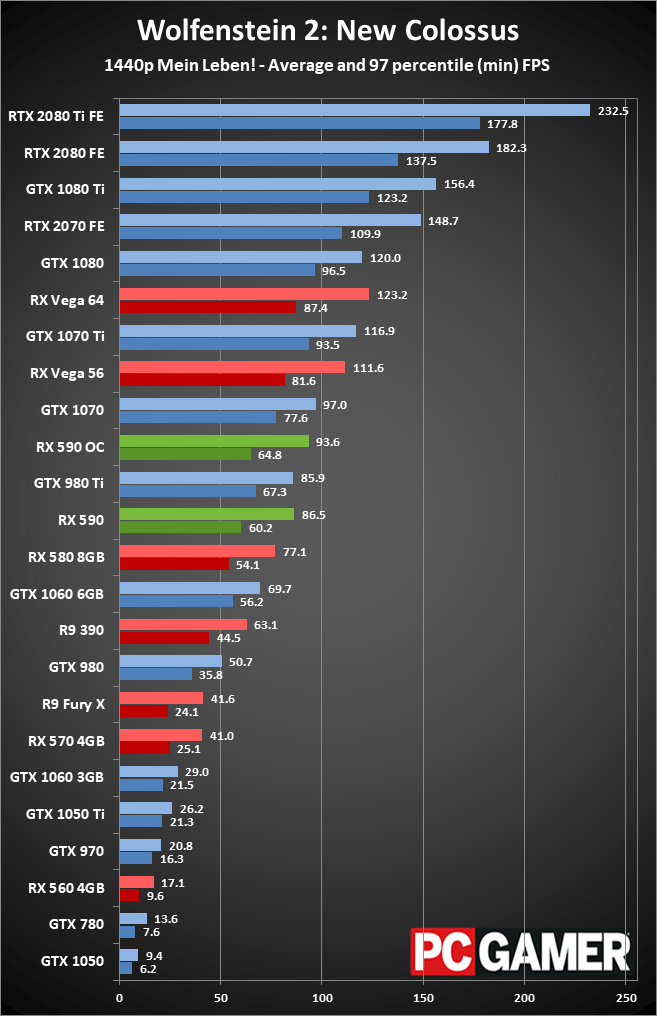
End of line.
1440p ultra might be a bit too much to ask of the RX 590, especially on some newer games, but you can tweak the settings and typically get 60+ fps at 1440p medium/high quality. The RX 590 averages just under 50fps in our gaming suite, with the same games as above dragging the average down. Overall, however, AMD's lead over the GTX 1060 6GB grows to 13 percent (and drops to 9 percent faster than the 580 8GB). Thanks to the 8GB GDDR5, the RX 590 also averages better performance than 2015's R9 Fury X, at less than half the price.
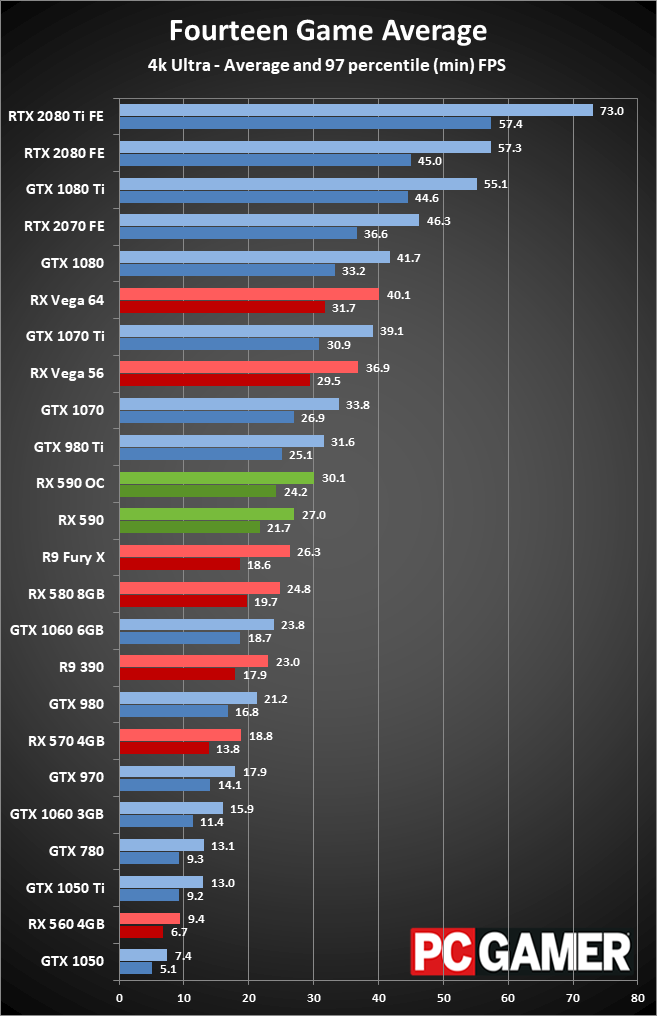
Swipe left/right for additional charts.
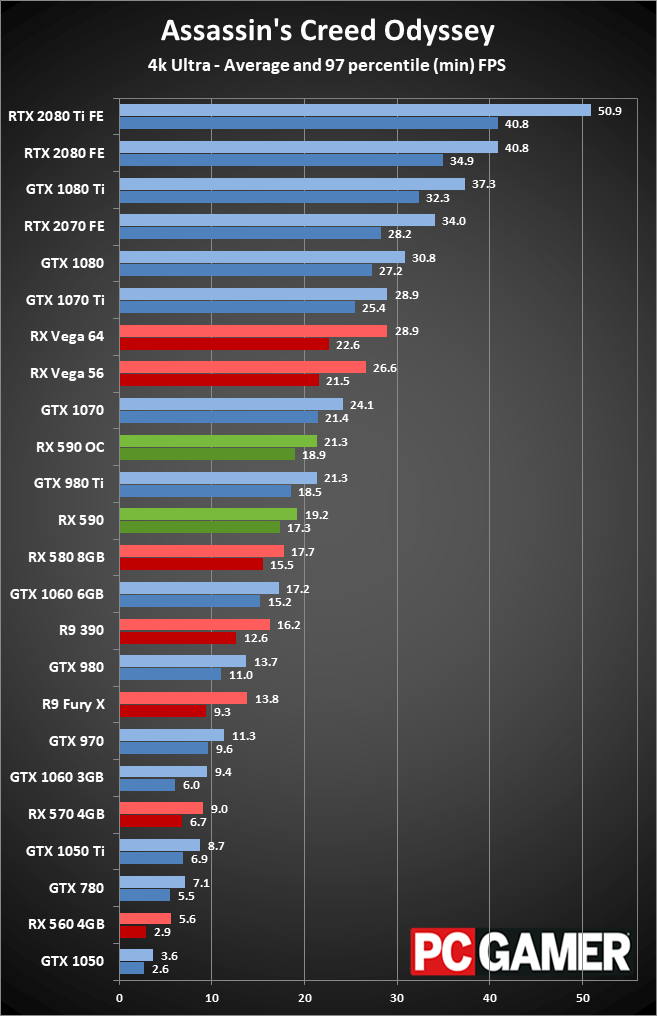
Swipe left/right for additional charts.
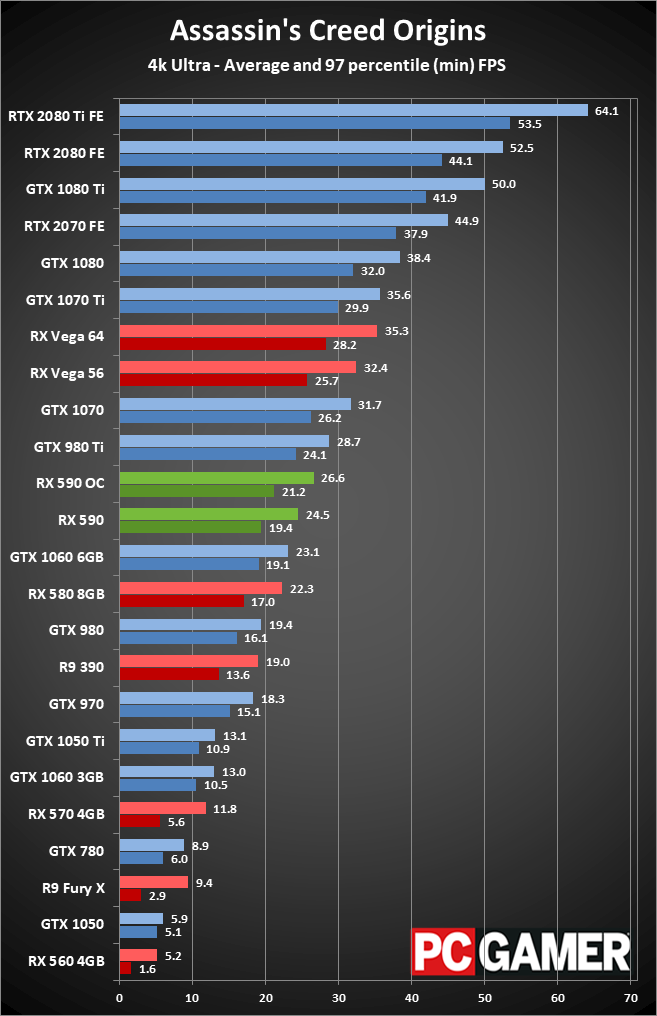
Swipe left/right for additional charts.
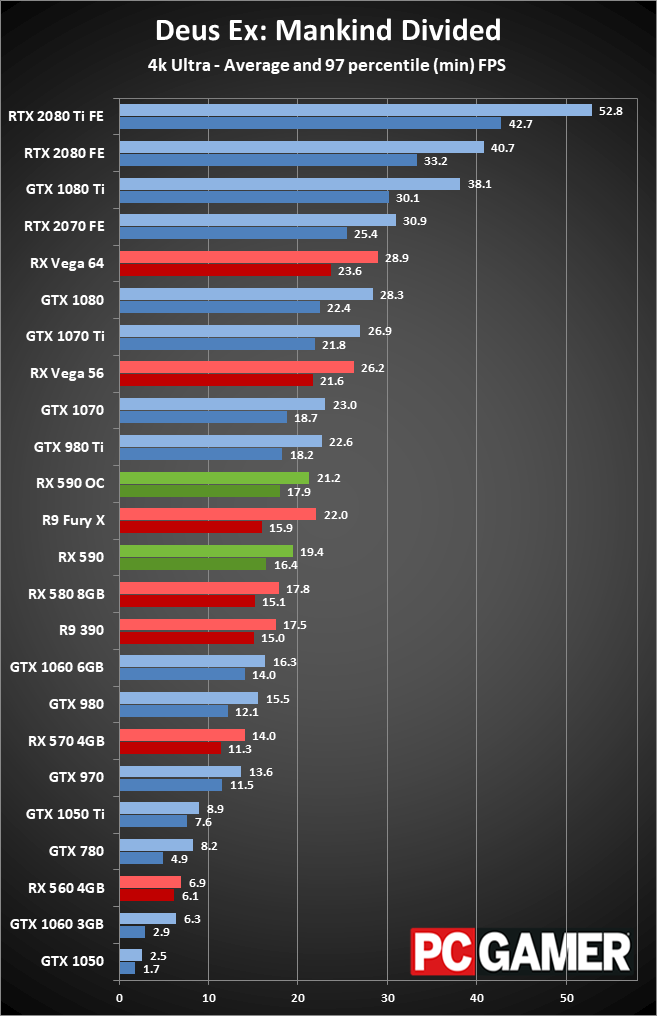
Swipe left/right for additional charts.
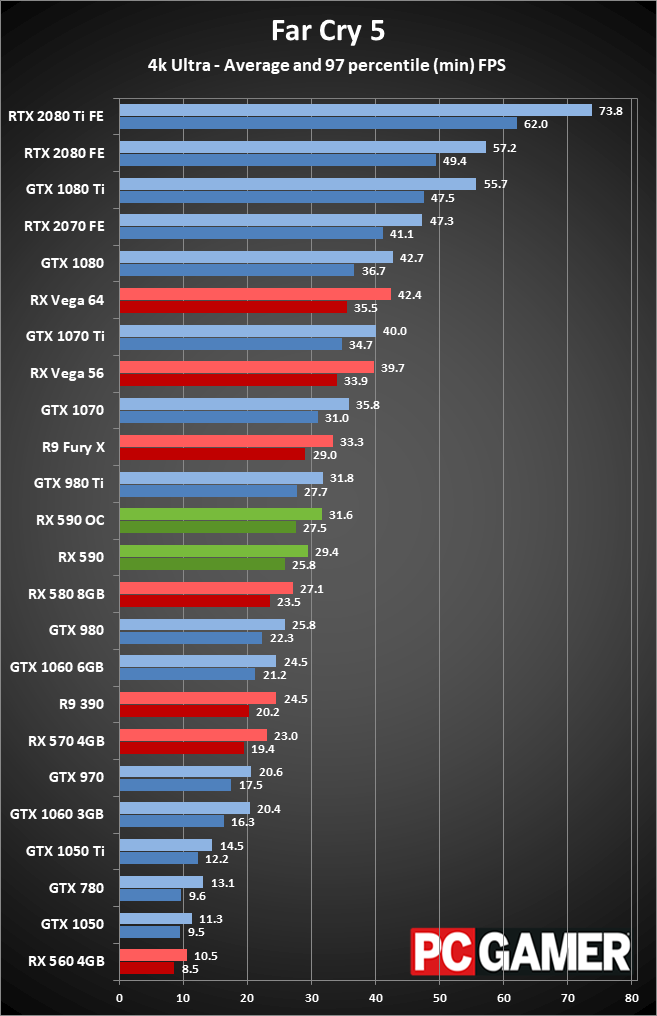
Swipe left/right for additional charts.
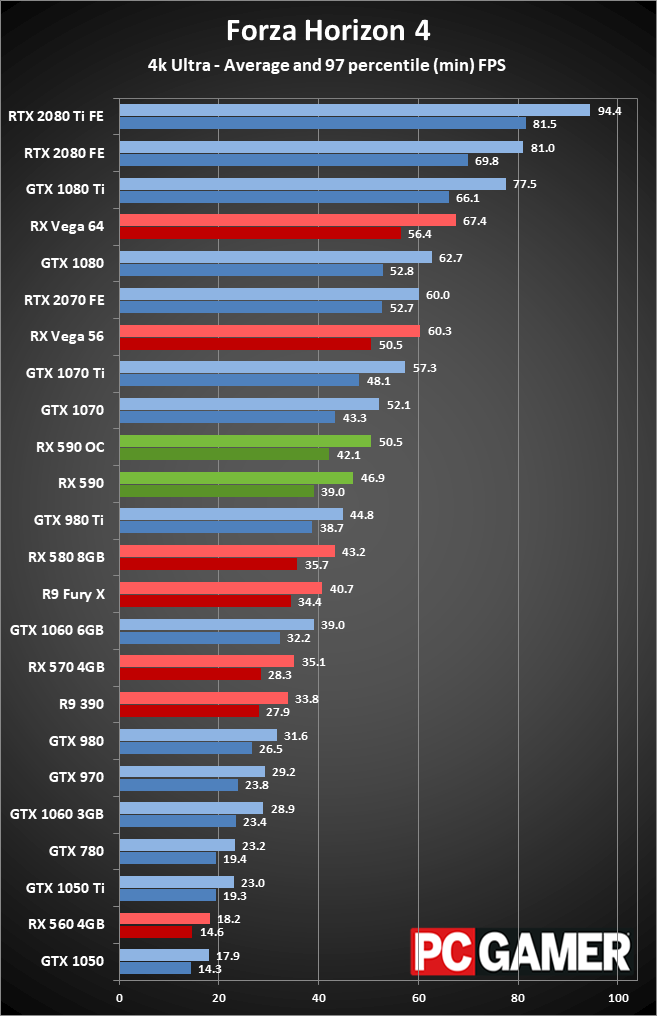
Swipe left/right for additional charts.
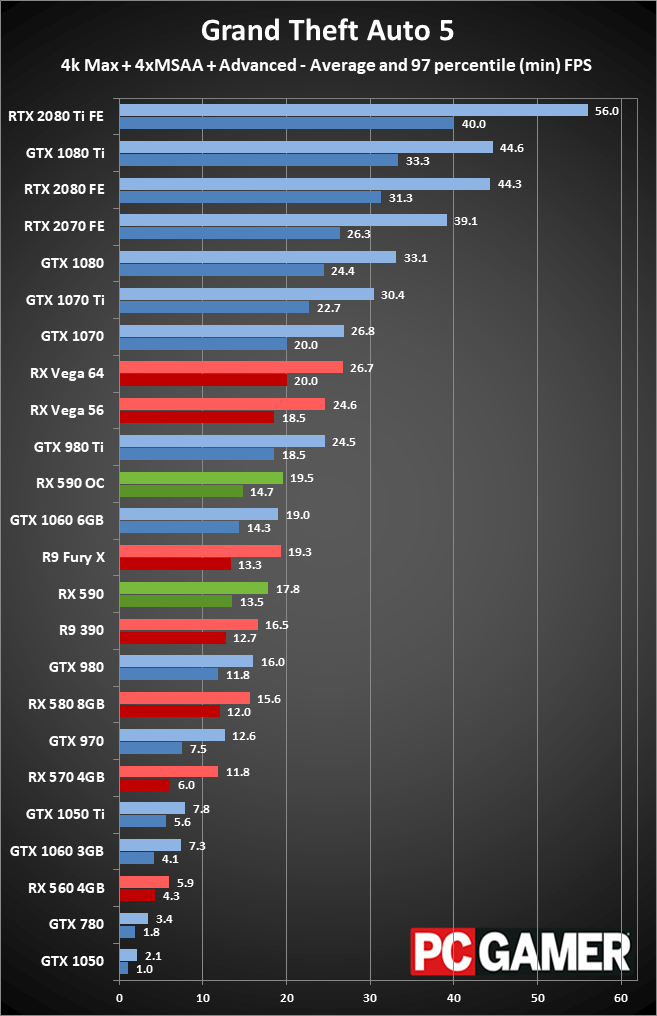
Easter Egg!
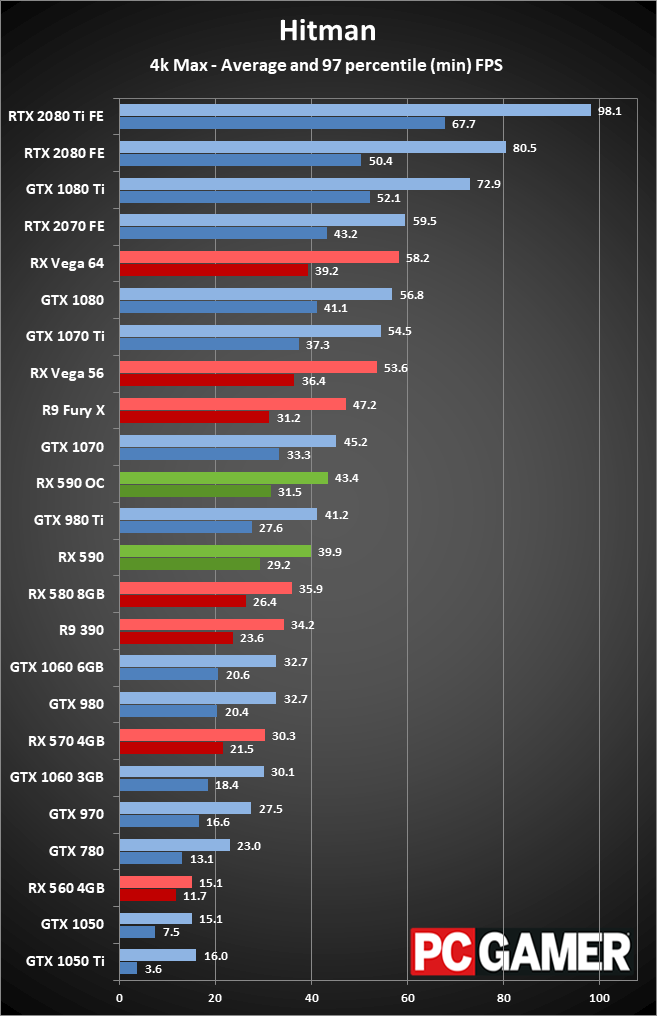
Swipe left/right for additional charts.
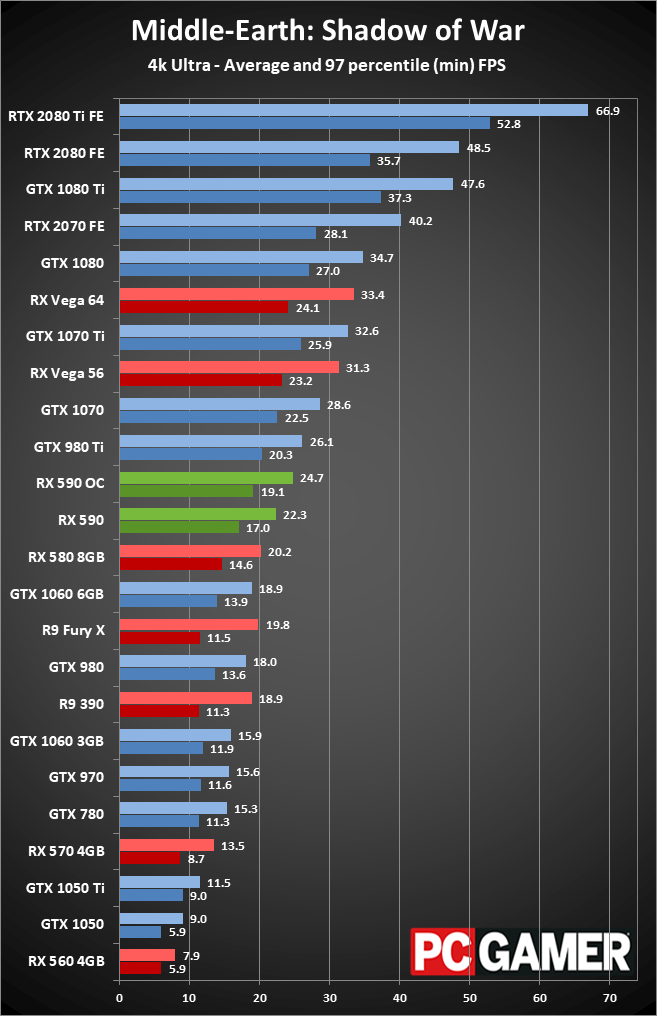
Swipe left/right for additional charts.
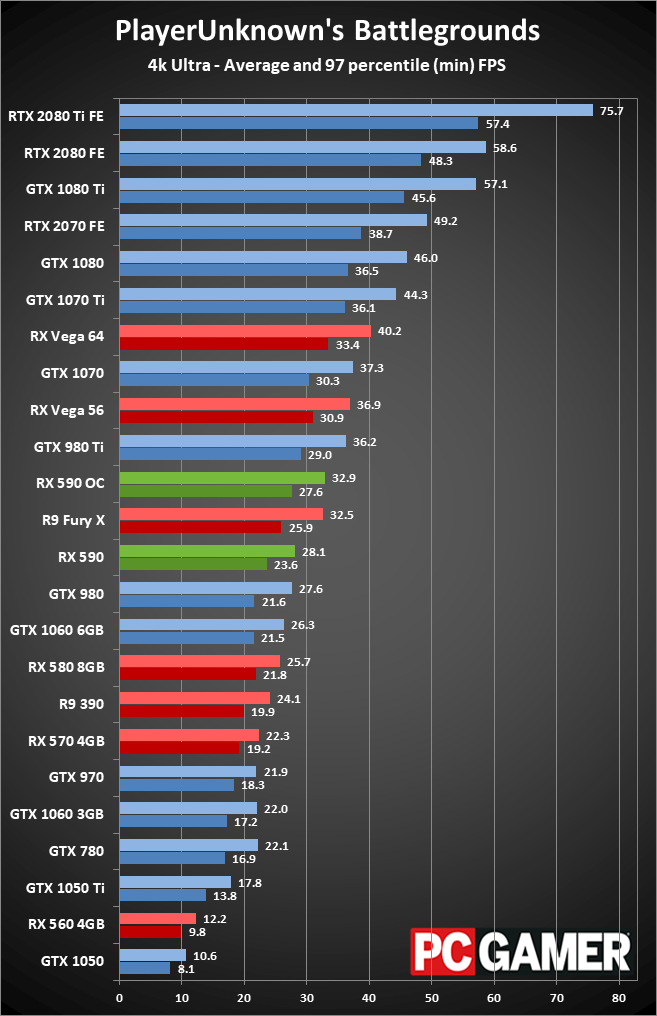
Swipe left/right for additional charts.
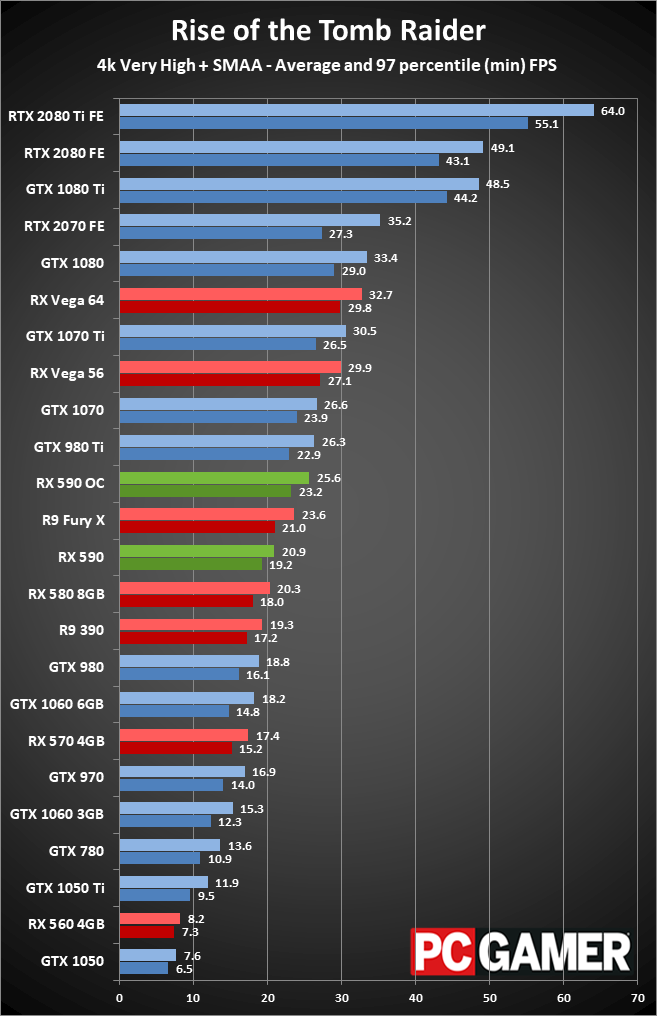
Swipe left/right for additional charts.
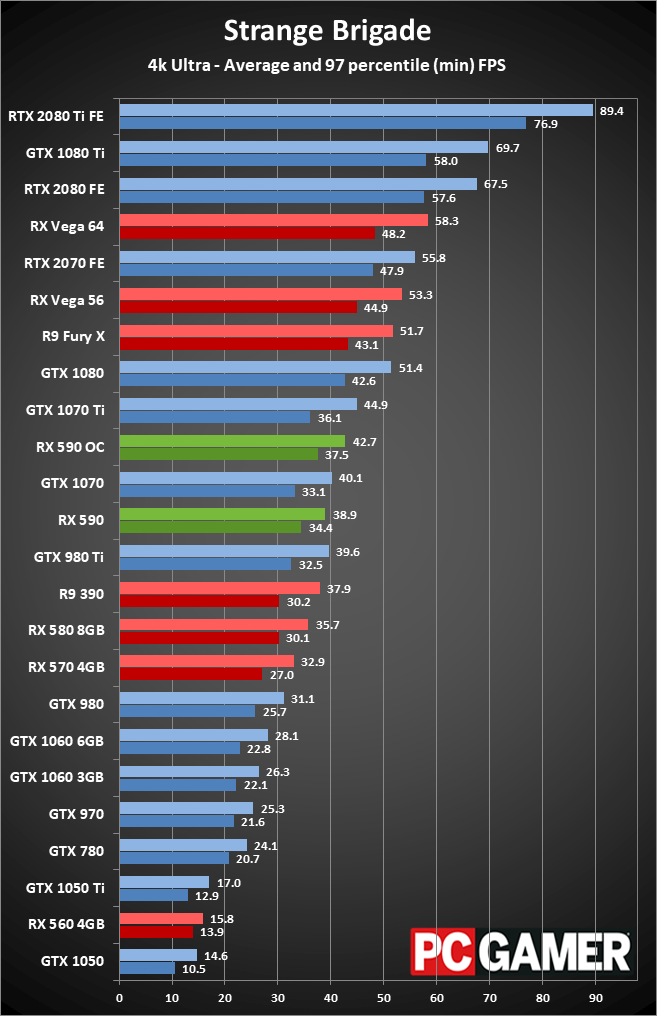
Swipe left/right for additional charts.
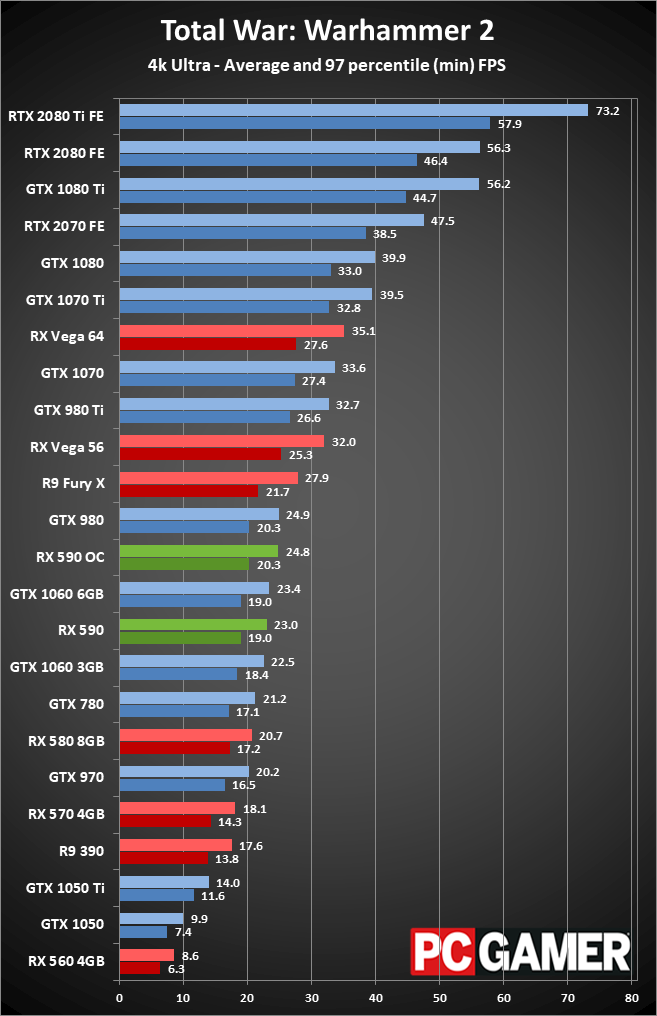
Swipe left/right for additional charts.

Swipe left/right for additional charts.

That's the last of the charts!
The RX 590 isn't meant for 4k, at least not in the demanding games from our test suite. It would do great in Overwatch or CS:GO, though. Going from 1440p to 4k typically cuts performance in half, assuming you don't run out of VRAM (eg, all the 4GB and lower GPUs), and the RX 590 follows that trend. A few of the games we test might break 60fps at 4k medium/high, but in general you'll want to stick with a lower resolution.

Radeon RX 590 is great value, especially if you want the game bundle

Swipe left/right for additional charts.

Swipe left/right for additional charts.

Swipe left/right for additional charts.

Swipe left/right for additional charts.

Swipe left/right for additional charts.

Swipe left/right for additional charts.
Looking at performance combined with price, the RX 590 does pretty well overall. The RX 570/580 are easy picks at the current prices, if all you're looking at is a GPU upgrade. If you're building a complete midrange PC, however, the RX 590 moves up the charts. The system builds use a relatively high-end PC, however (around $1,000), which skews things a bit more in favor of the high-end graphics cards. Overall, the 590 isn't an incredible value, but it's reasonably priced—and that's before you factor in the game bundle. If you're thinking about buying any or all of the games from the bundle, it's practically a no-brainer.
As I discussed in the RTX 2070 review, most people can't afford the fastest graphics card, with $200-$300 models accounting for about a third of all GPUs currently in use. These midrange offerings are called 'mainstream' for a reason. They'll do everything you might need, just not at maximum quality or performance. They're the midsize sedans of the graphics world. As for the RX 590, it's a good process shrink of a two-year-old GPU.

I have to wonder what things might have looked like this year without the cryptocurrency insanity affecting things. RX 580 was originally a $239 GPU, but for a while it was selling at over twice that (if you could even find one in stock). It feels like both AMD and Nvidia took that as a sign to increase prices on each tier of GPU performance, with the GeForce RTX line being particularly painful on the wallet. AMD claims the RX 590 is 12 percent faster than its predecessor, and that's about right for my benchmarks (9-10 percent, but close enough). That's not bad, but it's one small step rather than a giant leap.
Nvidia continues to rule the high-end market, and it also has an enormous market share if you focus just on the past couple of generations of discrete graphics cards. We need AMD to bring more competition to the GPU market, and while Polaris part three isn't going to dethrone any of the high-end cards, it's at least a card most gamers could afford. Hopefully it's also enough to keep AMD GPUs relevant while we wait for Navi and the 7nm wars of 2019.
Should you buy an RX 590? That depends on what you're doing. Most existing gaming PCs should already have a reasonable alternative. If you didn't buy a GTX 1060 6GB or RX 480/580 8GB any time during the past couple of years, RX 590 isn't going to change your mind. But for new PC builds, especially for the popular midrange market, it's now arguably the best option. Just don't be surprised if Nvidia has something to say about that in the coming months.
The Radeon RX 590 brings modest improvements to the midrange sector, and despite the price increase, it's the sensible alternative to Nvidia's RTX line.
Jarred's love of computers dates back to the dark ages when his dad brought home a DOS 2.3 PC and he left his C-64 behind. He eventually built his first custom PC in 1990 with a 286 12MHz, only to discover it was already woefully outdated when Wing Commander was released a few months later. He holds a BS in Computer Science from Brigham Young University and has been working as a tech journalist since 2004, writing for AnandTech, Maximum PC, and PC Gamer. From the first S3 Virge '3D decelerators' to today's GPUs, Jarred keeps up with all the latest graphics trends and is the one to ask about game performance.



